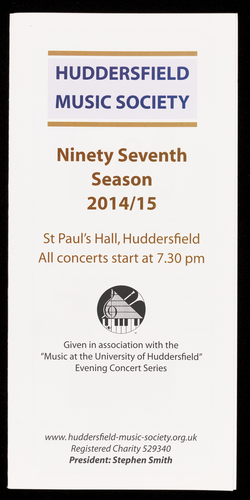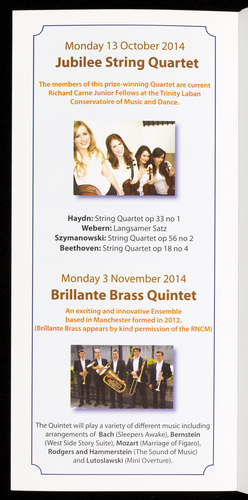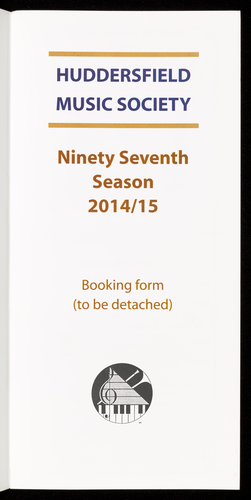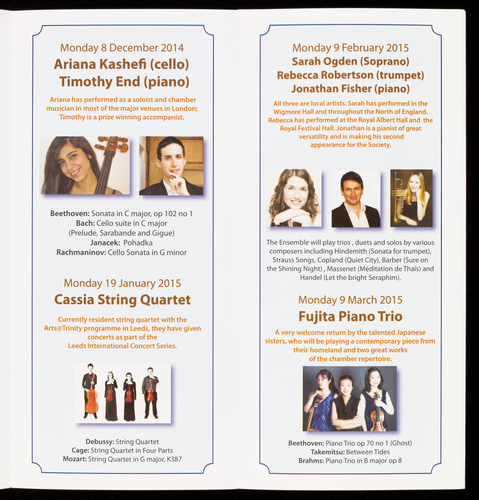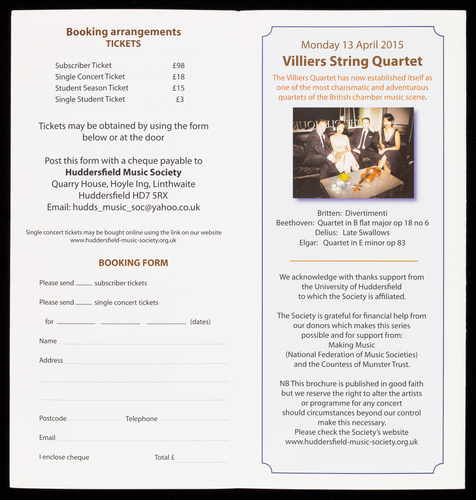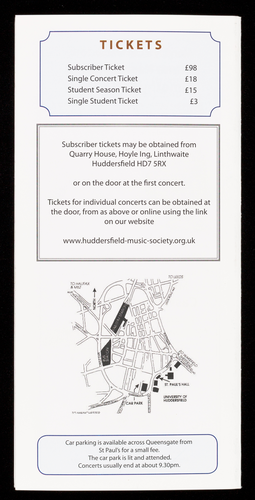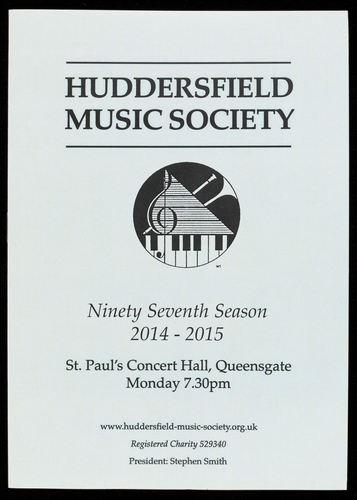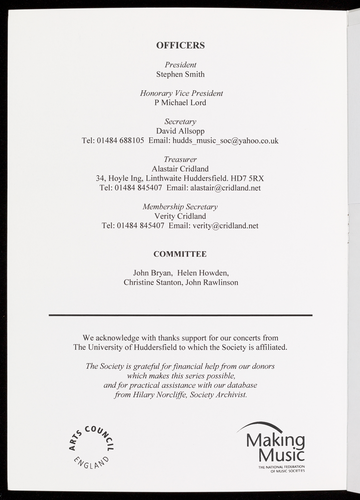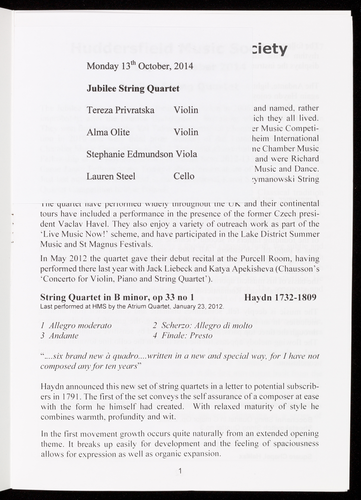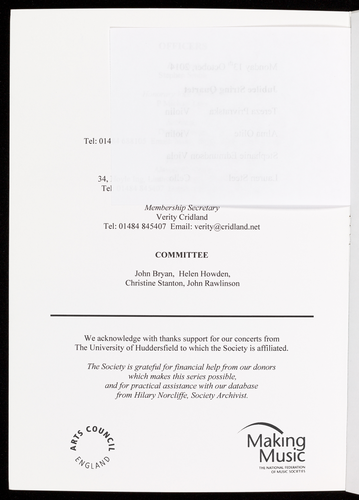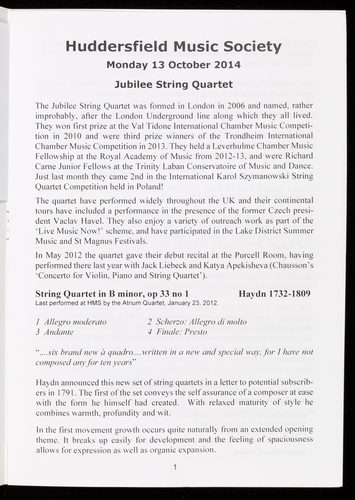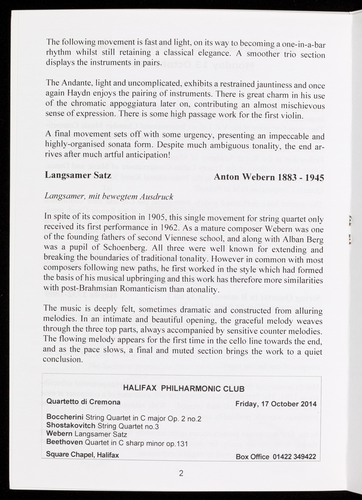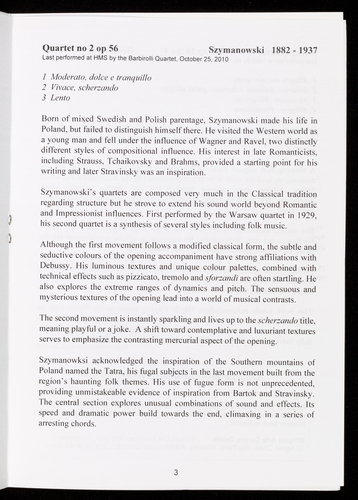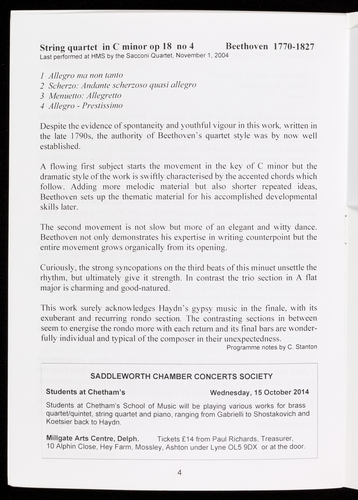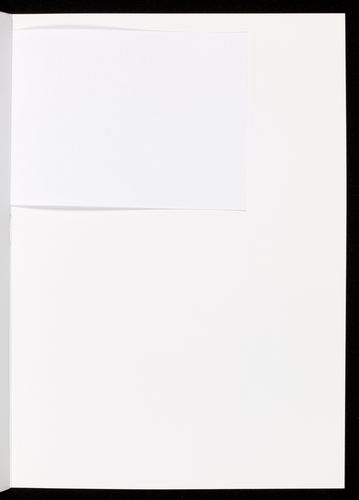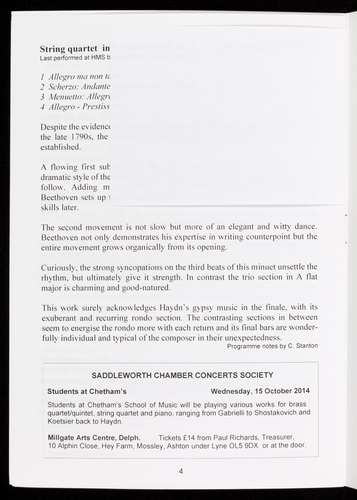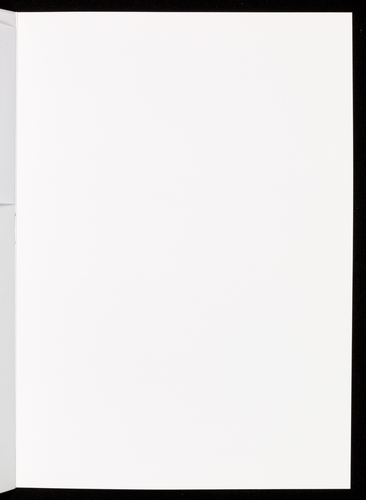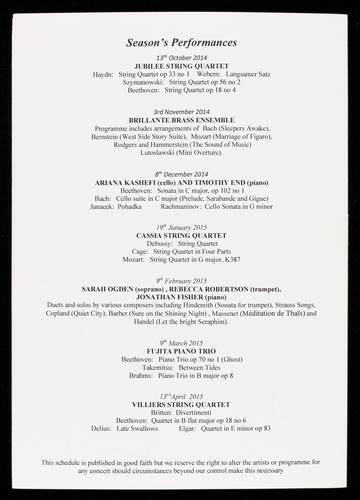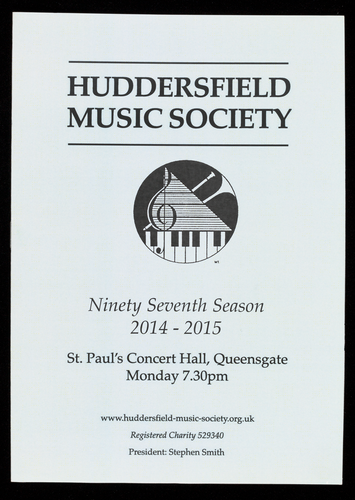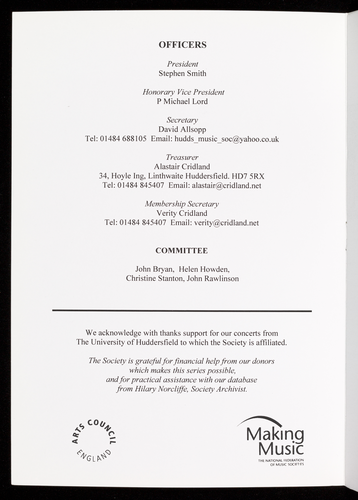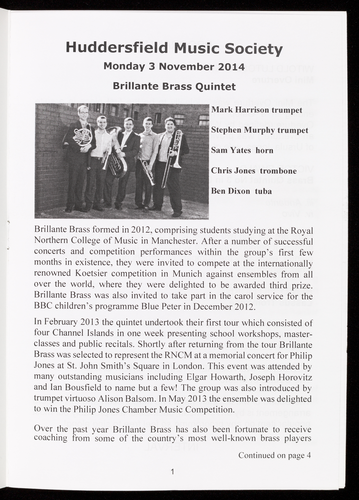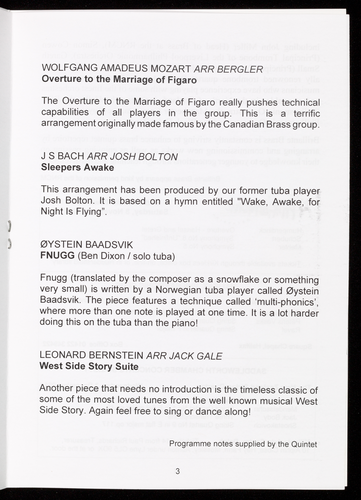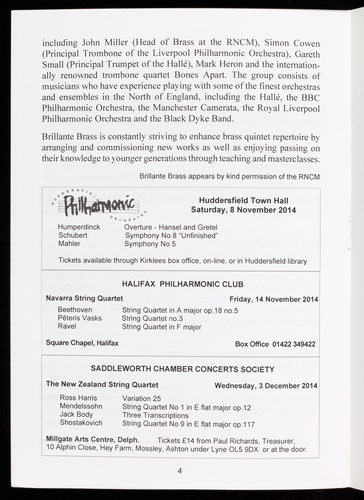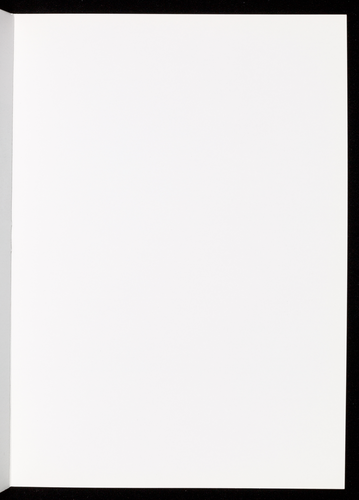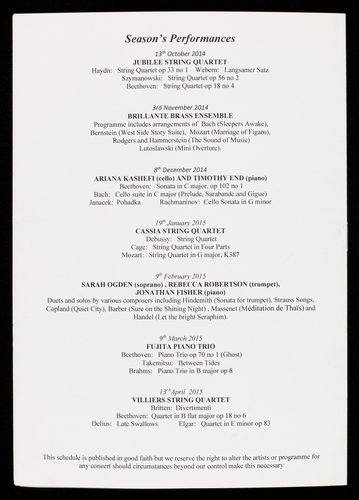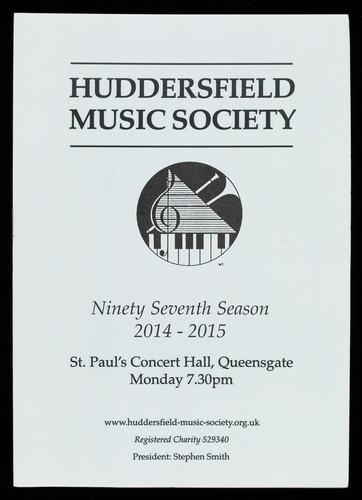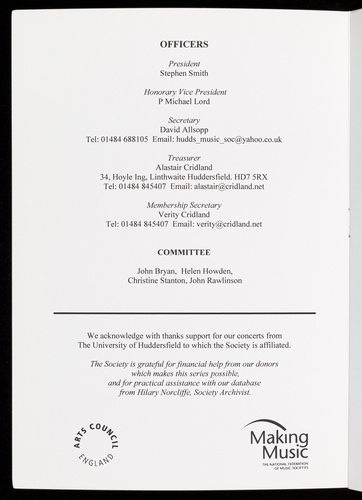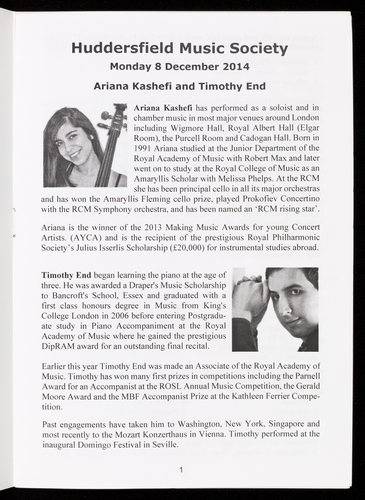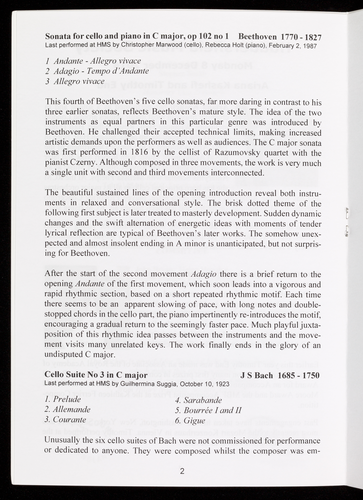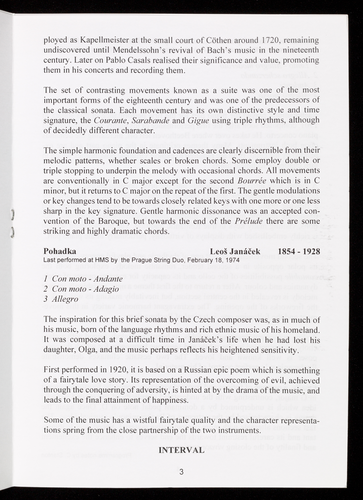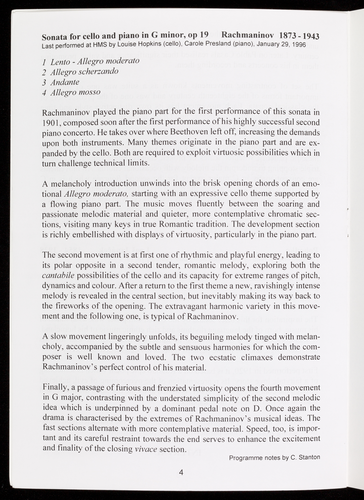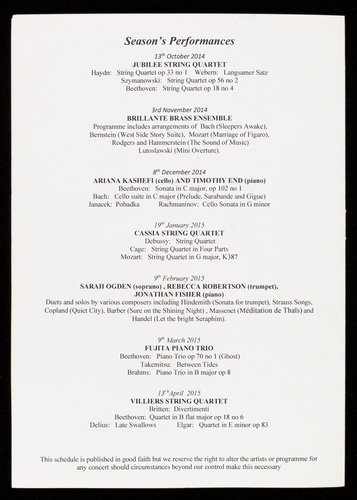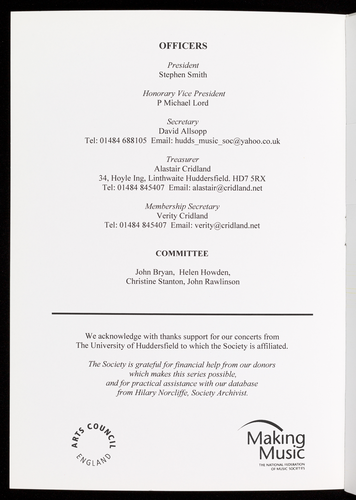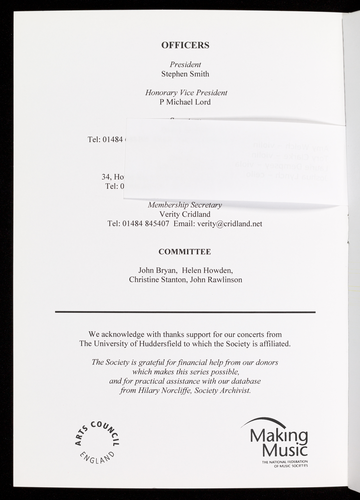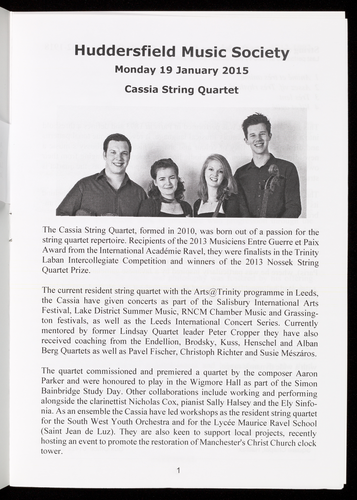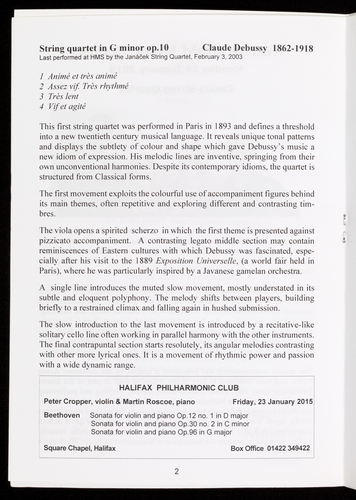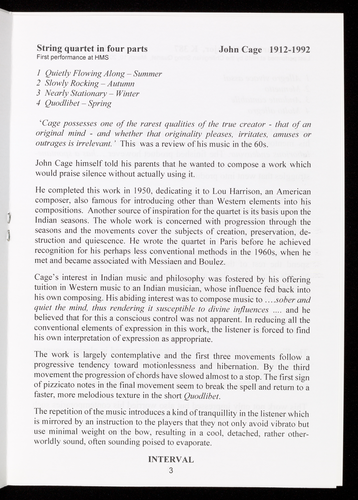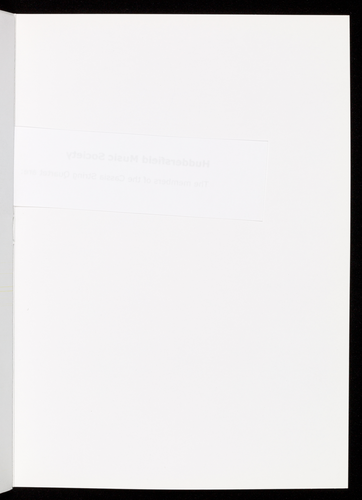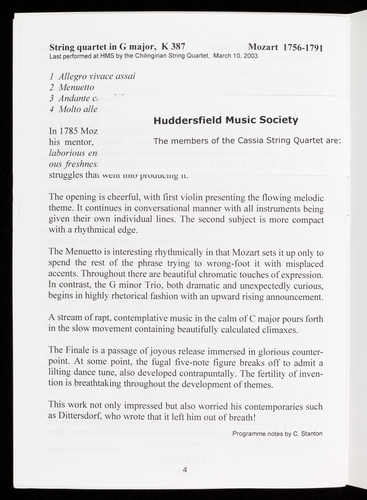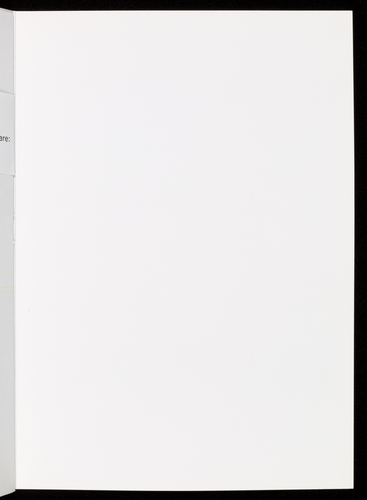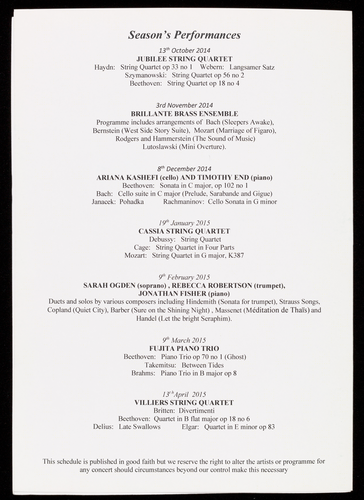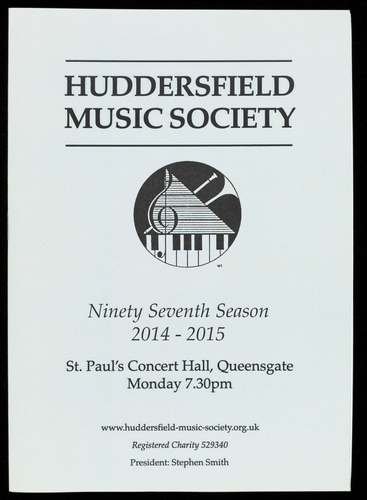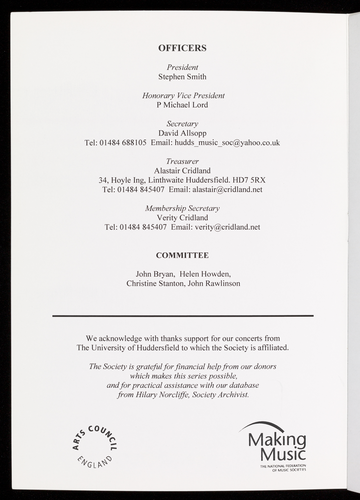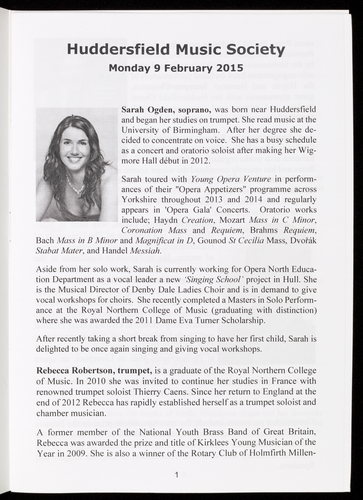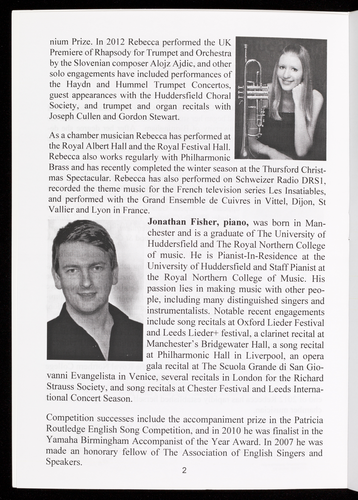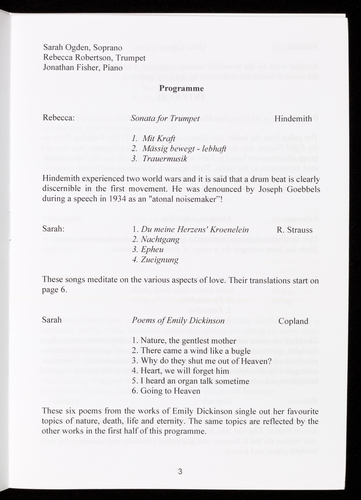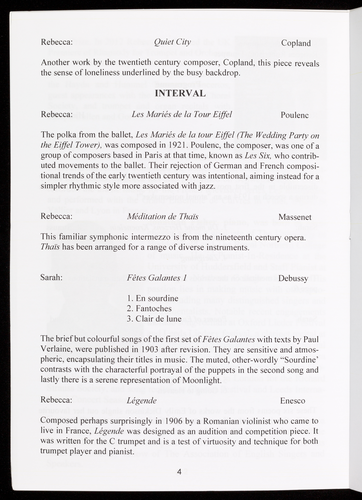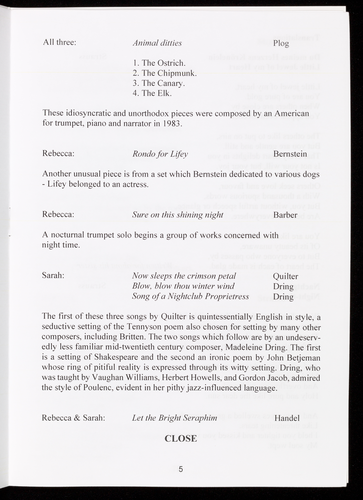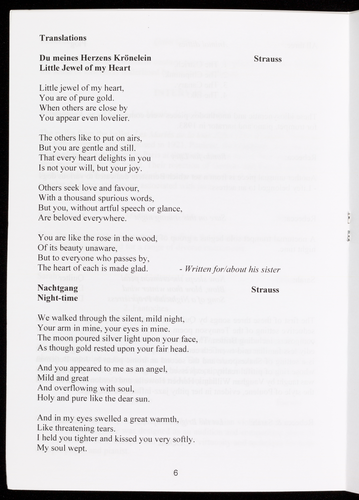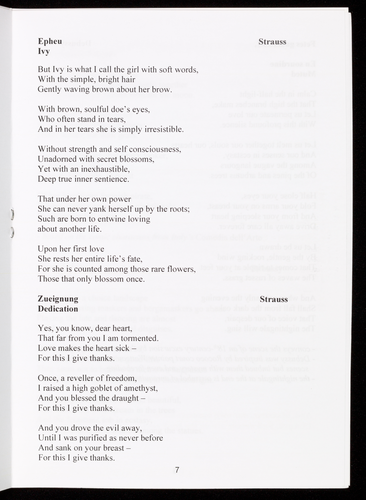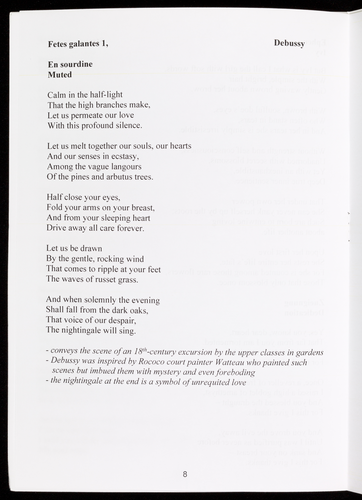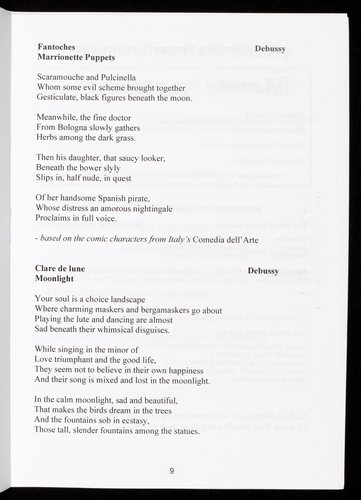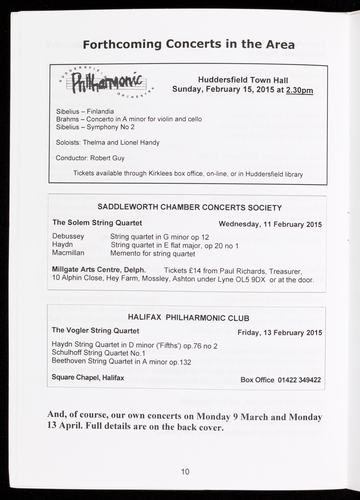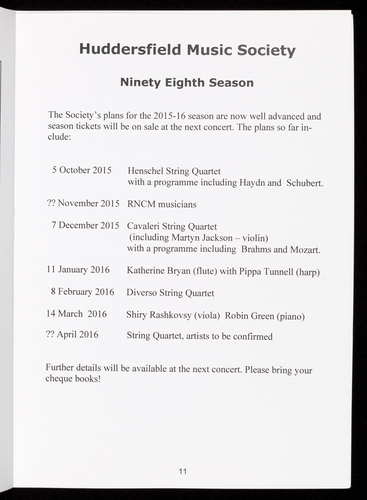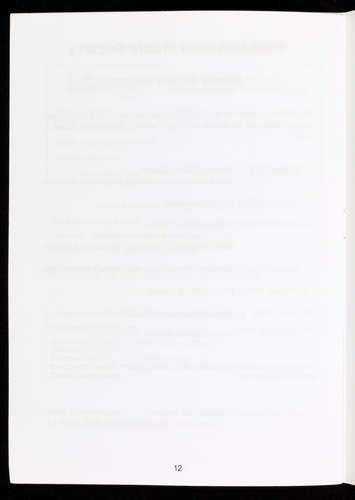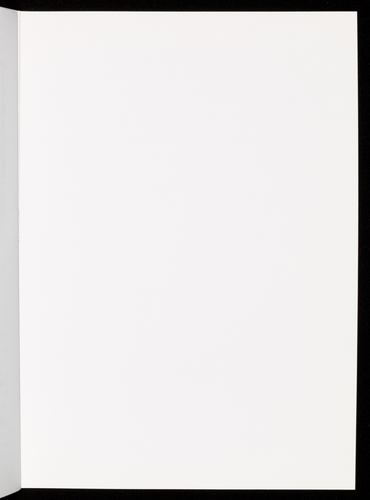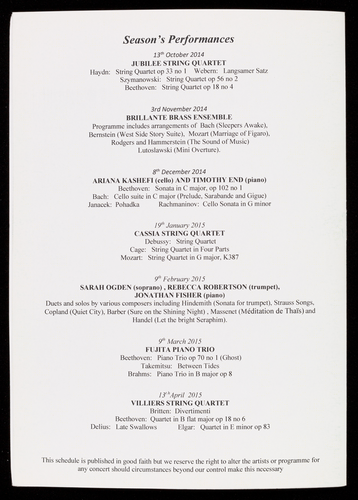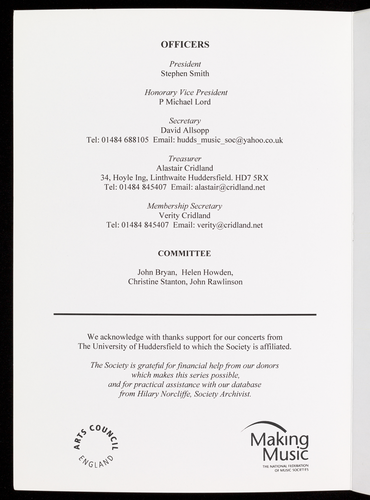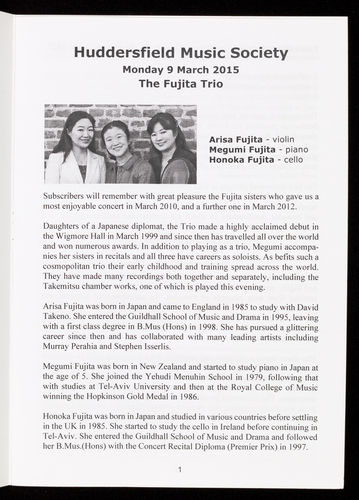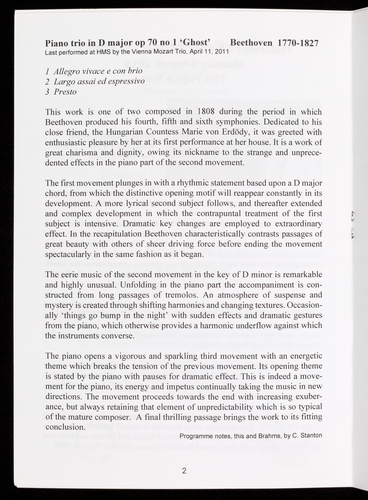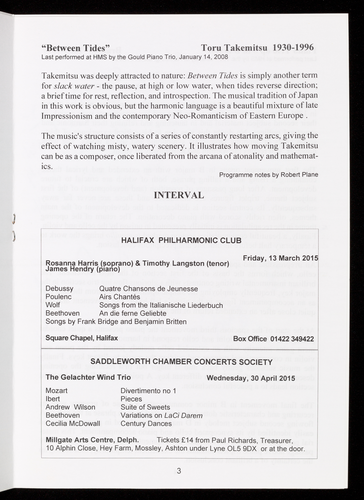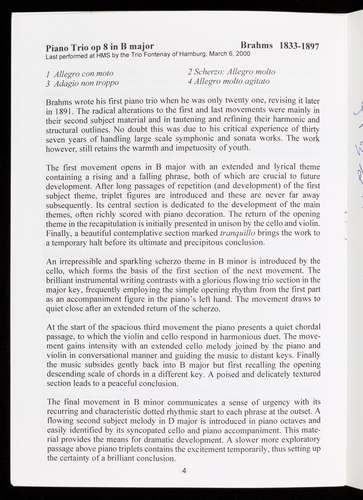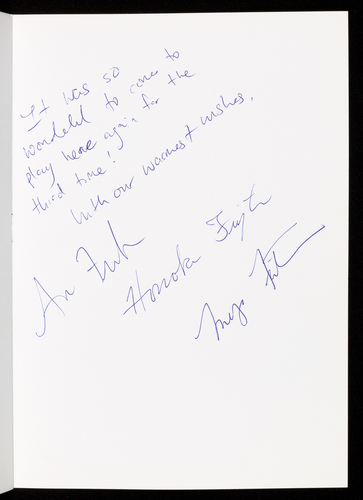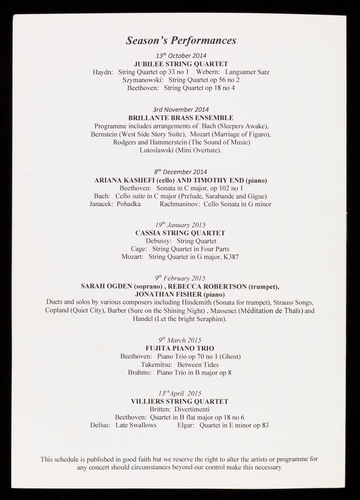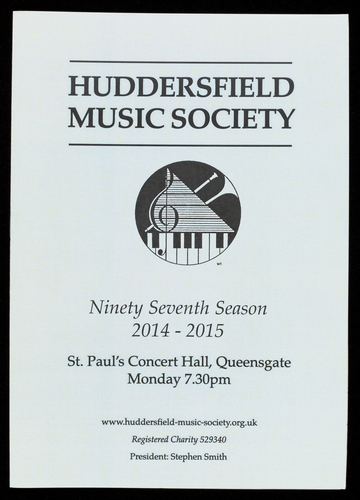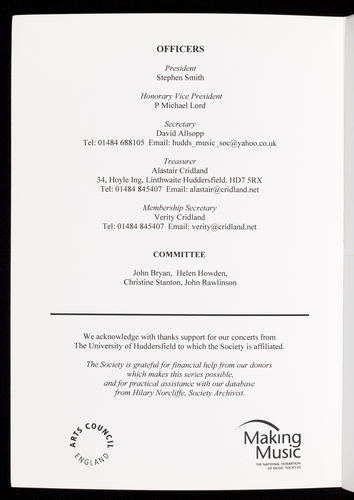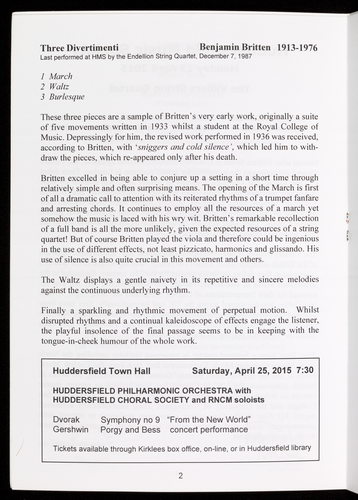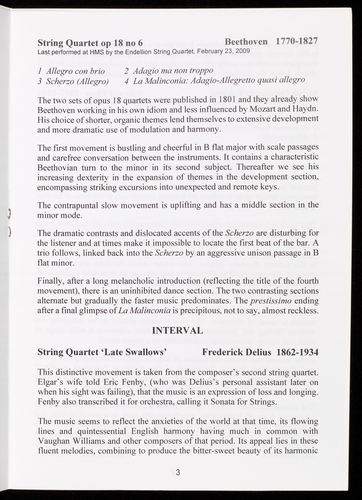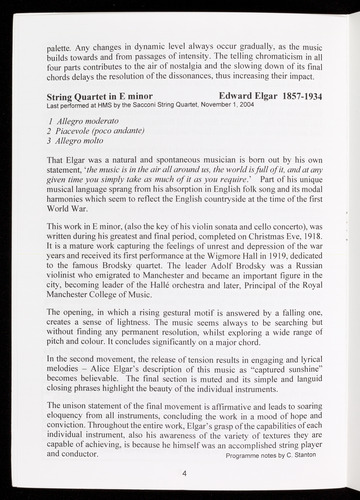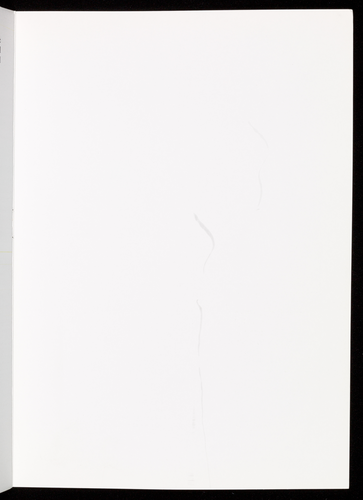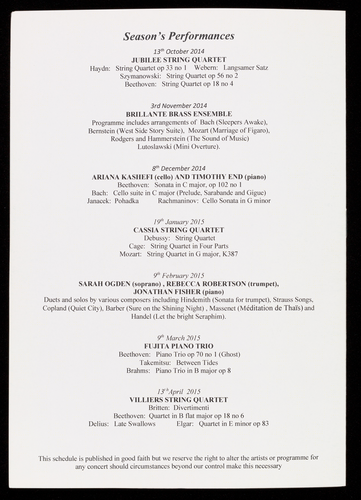Ocr'd Text:
HUDDERSFIELD
MUSIC SOCIETY
Ninety Seventh
Season
2014/15
St Paul's Hall, Huddersfield
All concerts start at 7.30 pm
WT.
Given in association with the
"Music at the University of Huddersfield"
Evening Concert Series
www.huddersfield-music-society.org.uk
Registered Charity 529340
President: Stephen Smith
Ocr'd Text:
Monday 13 October 2014
Jubilee String Quartet
The members of this prize-winning Quartet are current
Richard Carne Junior Fellows at the Trinity Laban
Conservatoire of Music and Dance.
nea
QUAD
Haydn: String Quartet op 33 no 1
Webern: Langsamer Satz
Szymanowski: String Quartet op 56 no 2
Beethoven: String Quartet op 18 no 4
Monday 3 November 2014
Brillante Brass Quintet
An exciting and innovative Ensemble
based in Manchester formed in 2012.
(Brillante Brass appears by kind permission of the RNCM)
The Quintet will play a variety of different music including
arrangements of Bach (Sleepers Awake), Bernstein
(West Side Story Suite), Mozart (Marriage of Figaro),
Rodgers and Hammerstein (The Sound of Music)
and Lutoslawski (Mini Overture).
Ocr'd Text:
HUDDERSFIELD
MUSIC SOCIETY
Ninety Seventh
Season
2014/15
Booking form
(to be detached)
M
WT
Ocr'd Text:
Monday 8 December 2014
Ariana Kashefi (cello)
Timothy End (piano)
Ariana has performed as a soloist and chamber
musician in most of the major venues in London;
Timothy is a prize winning accompanist.
A
Beethoven: Sonata in C major, op 102 no 1
Bach: Cello suite in C major
(Prelude, Sarabande and Gigue)
Janacek: Pohadka
Rachmaninov: Cello Sonata in G minor
Monday 19 January 2015
Cassia String Quartet
Currently resident string quartet with the
Arts@Trinity programme in Leeds, they have given
concerts as part of the
Leeds International Concert Series.
Debussy: String Quartet
Cage: String Quartet in Four Parts
Mozart: String Quartet in G major, K387
Monday 9 February 2015
Sarah Ogden (Soprano)
Rebecca Robertson (trumpet)
Jonathan Fisher (piano)
All three are local artists. Sarah has performed in the
Wigmore Hall and throughout the North of England.
Rebecca has performed at the Royal Albert Hall and the
Royal Festival Hall. Jonathan is a pianist of great
versatility and is making his second
appearance for the Society.
The Ensemble will play trios, duets and solos by various
composers including Hindemith (Sonata for trumpet),
Strauss Songs, Copland (Quiet City), Barber (Sure on
the Shining Night), Massenet (Méditation de Thaïs) and
Handel (Let the bright Seraphim).
Monday 9 March 2015
Fujita Piano Trio
A very welcome return by the talented Japanese
sisters, who will be playing a contemporary piece from
their homeland and two great works
of the chamber repertoire.
FOR
Beethoven: Piano Trio op 70 no 1 (Ghost)
Takemitsu: Between Tides
Brahms: Piano Trio in B major op 8
Ocr'd Text:
Subscriber Ticket
Single Concert Ticket
Student Season Ticket
Single Student Ticket
Tickets may be obtained by using the form
below or at the door
Booking arrangements
Post this form with a cheque payable to
Huddersfield Music Society
Quarry House, Hoyle Ing, Linthwaite
Huddersfield HD7 5RX
Email: hudds_music_soc@yahoo.co.uk
for
Single concert tickets may be bought online using the link on our website
www.huddersfield-music-society.org.uk
TICKETS
Please send ............ subscriber tickets
Name
Please send ............ single concert tickets
Address
Postcode
Email
..........
BOOKING FORM
I enclose cheque
£98
£18
£15
£3
...........
...........
.............. ...........
Telephone
Total £
(dates)
Monday 13 April 2015
Villiers String Quartet
The Villiers Quartet has now established itself as
one of the most charismatic and adventurous
quartets of the British chamber music scene.
AUOI LIH
Britten: Divertimenti
Beethoven: Quartet in B flat major op 18 no 6
Delius: Late Swallows
Elgar: Quartet in E minor op 83
We acknowledge with thanks support from
the University of Huddersfield
to which the Society is affiliated.
The Society is grateful for financial help from
our donors which makes this series
possible and for support from:
Making Music
(National Federation of Music Societies)
and the Countess of Munster Trust.
NB This brochure is published in good faith
but we reserve the right to alter the artists
or programme for any concert
should circumstances beyond our control
make this necessary.
Please check the Society's website
www.huddersfield-music-society.org.uk
Ocr'd Text:
Subscriber Ticket
Single Concert Ticket
Student Season Ticket
Single Student Ticket
Subscriber tickets may be obtained from
Quarry House, Hoyle Ing, Linthwaite
Huddersfield HD7 5RX
or on the door at the first concert.
Tickets for individual concerts can be obtained at
the door, from as above or online using the link
on our website
TO HALIFAX
& M62
TICKETS
www.huddersfield-music-society.org.uk
NEW NORTH RACK
TRINITY STREET
16
NORTH
ASTUSY
TE MAANHESTER
A62 MANCHESTE
OLAD
NGAIVIS AVAXINM
1009
00000
5000
2008
QUEEN GATE
CAR PARK
£98
£18
£15
£3
LARGESTECANO
TO LEEDS
D
SHEFFIELD
WAKEFIELD
WAR WAKEFIELD ROAD
ST. PAUL'S HALL
UNIVERSITY OF
HUDDERSFIELD
The car park is lit and attended.
Concerts usually end at about 9.30pm.
Car parking is available across Queensgate from
St Paul's for a small fee.
Ocr'd Text:
HUDDERSFIELD
MUSIC SOCIETY
WT.
Ninety Seventh Season
2014-2015
St. Paul's Concert Hall, Queensgate
Monday 7.30pm
www.huddersfield-music-society.org.uk
Registered Charity 529340
President: Stephen Smith
Ocr'd Text:
ARTS
Secretary
David Allsopp
Tel: 01484 688105 Email: hudds_music_soc@yahoo.co.uk
OFFICERS
со
President
Stephen Smith
Honorary Vice President
P Michael Lord
Treasurer
Alastair Cridland
34, Hoyle Ing, Linthwaite Huddersfield. HD7 5RX
Tel: 01484 845407 Email: alastair@cridland.net
COUNCIL
Membership Secretary
Verity Cridland
Tel: 01484 845407 Email: verity@cridland.net
We acknowledge with thanks support for our concerts from
The University of Huddersfield to which the Society is affiliated.
ENGLAND
COMMITTEE
The Society is grateful for financial help from our donors
which makes this series possible,
and for practical assistance with our database
from Hilary Norcliffe, Society Archivist.
John Bryan, Helen Howden,
Christine Stanton, John Rawlinson
Making
Music
THE NATIONAL FEDERATION
OF MUSIC SOCIETIES
Ocr'd Text:
Monday 13th October, 2014
Jubilee String Quartet
Tereza Privratska Violin
Alma Olite
Stephanie Edmundson Viola
Lauren Steel
Violin
Cello
1 Allegro moderato
3 Andante
The quartet have performed widely throughout the UK and their continental
tours have included a performance in the presence of the former Czech presi-
dent Vaclav Havel. They also enjoy a variety of outreach work as part of the
'Live Music Now!' scheme, and have participated in the Lake District Summer
Music and St Magnus Festivals.
String Quartet in B minor, op 33 no 1
Last performed at HMS by the Atrium Quartet, January 23, 2012.
ciety
In May 2012 the quartet gave their debut recital at the Purcell Room, having
performed there last year with Jack Liebeck and Katya Apekisheva (Chausson's
'Concerto for Violin, Piano and String Quartet').
and named, rather
ich they all lived.
er Music Competi-
heim International
ne Chamber Music
and were Richard
Music and Dance.
ymanowski String
Haydn 1732-1809
2 Scherzo: Allegro di molto
4 Finale: Presto
"....six brand new à quadro....written in a new and special way, for I have not
composed any for ten years"
1
Haydn announced this new set of string quartets in a letter to potential subscrib-
ers in 1791. The first of the set conveys the self assurance of a composer at ease
with the form he himself had created. With relaxed maturity of style he
combines warmth, profundity and wit.
In the first movement growth occurs quite naturally from an extended opening
theme. It breaks up easily for development and the feeling of spaciousness
allows for expression as well as organic expansion.
Ocr'd Text:
Tel: 014
ARTS
34,1
Tel
со
$10$ doo "El ysbnoM
COUNCIL
slotV noabnumbel sinsriqp12
Membership Secretary
Verity Cridland
Tel: 01484 845407 Email: verity@cridland.net
We acknowledge with thanks support for our concerts from
The University of Huddersfield to which the Society is affiliated.
ENGLAND
COMMITTEE
The Society is grateful for financial help from our donors
which makes this series possible,
and for practical assistance with our database
from Hilary Norcliffe, Society Archivist.
John Bryan, Helen Howden,
Christine Stanton, John Rawlinson
Making
Music
THE NATIONAL FEDERATION
OF MUSIC SOCIETIES
Ocr'd Text:
Huddersfield Music Society
Monday 13 October 2014
Jubilee String Quartet
The Jubilee String Quartet was formed in London in 2006 and named, rather
improbably, after the London Underground line along which they all lived.
They won first prize at the Val Tidone International Chamber Music Competi-
tion in 2010 and were third prize winners of the Trondheim International
Chamber Music Competition in 2013. They held a Leverhulme Chamber Music
Fellowship at the Royal Academy of Music from 2012-13, and were Richard
Carne Junior Fellows at the Trinity Laban Conservatoire of Music and Dance.
Just last month they came 2nd in the International Karol Szymanowski String
Quartet Competition held in Poland!
The quartet have performed widely throughout the UK and their continental
tours have included a performance in the presence of the former Czech presi-
dent Vaclav Havel. They also enjoy a variety of outreach work as part of the
*Live Music Now!' scheme, and have participated in the Lake District Summer
Music and St Magnus Festivals.
In May 2012 the quartet gave their debut recital at the Purcell Room, having
performed there last year with Jack Liebeck and Katya Apekisheva (Chausson's
'Concerto for Violin, Piano and String Quartet’).
String Quartet in B minor, op 33 no 1
Last performed at HMS by the Atrium Quartet, January 23, 2012.
1 Allegro moderato
3 Andante
Haydn 1732-1809
2 Scherzo: Allegro di molto
4 Finale: Presto
".....six brand new à quadro.... written in a new and special way, for I have not
composed any for ten years"
Haydn announced this new set of string quartets in a letter to potential subscrib-
ers in 1791. The first of the set conveys the self assurance of a composer at ease
with the form he himself had created. With relaxed maturity of style he
combines warmth, profundity and wit.
In the first movement growth occurs quite naturally from an extended opening
theme. It breaks up easily for development and the feeling of spaciousness
allows for expression as well as organic expansion.
1
Ocr'd Text:
The following movement is fast and light, on its way to becoming a one-in-a-bar
rhythm whilst still retaining a classical elegance. A smoother trio section.
displays the instruments in pairs.
The Andante, light and uncomplicated, exhibits a restrained jauntiness and once
again Haydn enjoys the pairing of instruments. There is great charm in his use
of the chromatic appoggiatura later on, contributing an almost mischievous
sense of expression. There is some high passage work for the first violin.
A final movement sets off with some urgency, presenting an impeccable and
highly-organised sonata form. Despite much ambiguous tonality, the end ar-
rives after much artful anticipation!
Langsamer Satz
Langsamer, mit bewegtem Ausdruck
In spite of its composition in 1905, this single movement for string quartet only
received its first performance in 1962. As a mature composer Webern was one
of the founding fathers of second Viennese school, and along with Alban Berg
was a pupil of Schoenberg. All three were well known for extending and
breaking the boundaries of traditional tonality. However in common with most
composers following new paths, he first worked in the style which had formed
the basis of his musical upbringing and this work has therefore more similarities.
with post-Brahmsian Romanticism than atonality.
The music is deeply felt, sometimes dramatic and constructed from alluring
melodies. In an intimate and beautiful opening, the graceful melody weaves
through the three top parts, always accompanied by sensitive counter melodies.
The flowing melody appears for the first time in the cello line towards the end,
and as the pace slows, a final and muted section brings the work to a quiet
conclusion.
HALIFAX PHILHARMONIC CLUB
Quartetto di Cremona
Boccherini String Quartet in C major Op. 2 no.2
Shostakovitch String Quartet no.3
Anton Webern 1883 - 1945
Webern Langsamer Satz
Beethoven Quartet in C sharp minor op.131
Square Chapel, Halifax
2
Friday, 17 October 2014
Box Office 01422 349422
Ocr'd Text:
}
Quartet no 2 op 56
Last performed at HMS by the Barbirolli Quartet, October 25, 2010
1 Moderato, dolce e tranquillo
2 Vivace, scherzando
3 Lento
Szymanowski 1882-1937
Born of mixed Swedish and Polish parentage, Szymanowski made his life in
Poland, but failed to distinguish himself there. He visited the Western world as
a young man and fell under the influence of Wagner and Ravel, two distinctly
different styles of compositional influence. His interest in late Romanticists,
including Strauss, Tchaikovsky and Brahms, provided a starting point for his
writing and later Stravinsky was an inspiration.
Szymanowski's quartets are composed very much in the Classical tradition.
regarding structure but he strove to extend his sound world beyond Romantic
and Impressionist influences. First performed by the Warsaw quartet in 1929,
his second quartet is a synthesis of several styles including folk music.
Although the first movement follows a modified classical form, the subtle and
seductive colours of the opening accompaniment have strong affiliations with
Debussy. His luminous textures and unique colour palettes, combined with
technical effects such as pizzicato, tremolo and sforzandi are often startling. He
also explores the extreme ranges of dynamics and pitch. The sensuous and
mysterious textures of the opening lead into a world of musical contrasts.
The second movement is instantly sparkling and lives up to the scherzando title,
meaning playful or a joke. A shift toward contemplative and luxuriant textures
serves to emphasize the contrasting mercurial aspect of the opening.
Szymanowksi acknowledged the inspiration of the Southern mountains of
Poland named the Tatra, his fugal subjects in the last movement built from the
region's haunting folk themes. His use of fugue form is not unprecedented,
providing unmistakeable evidence of inspiration from Bartok and Stravinsky.
The central section explores unusual combinations of sound and effects. Its
speed and dramatic power build towards the end, climaxing in a series of
arresting chords.
3
Ocr'd Text:
String quartet in C minor op 18 no 4
Last performed at HMS by the Sacconi Quartet, November 1, 2004
1 Allegro ma non tanto
2 Scherzo: Andante scherzoso quasi allegro
3 Menuetto: Allegretto
4 Allegro - Prestissimo
Beethoven 1770-1827
Despite the evidence of spontaneity and youthful vigour in this work, written in
the late 1790s, the authority of Beethoven's quartet style was by now well
established.
A flowing first subject starts the movement in the key of C minor but the
dramatic style of the work is swiftly characterised by the accented chords which
follow. Adding more melodic material but also shorter repeated ideas,
Beethoven sets up the thematic material for his accomplished developmental
skills later.
The second movement is not slow but more of an elegant and witty dance.
Beethoven not only demonstrates his expertise in writing counterpoint but the
entire movement grows organically from its opening.
Curiously, the strong syncopations on the third beats of this minuet unsettle the
rhythm, but ultimately give it strength. In contrast the trio section in A flat
major is charming and good-natured.
This work surely acknowledges Haydn's gypsy music in the finale, with its
exuberant and recurring rondo section. The contrasting sections in between
seem to energise the rondo more with each return and its final bars are wonder-
fully individual and typical of the composer in their unexpectedness.
Programme notes by C. Stanton
SADDLEWORTH CHAMBER CONCERTS SOCIETY
Students at Chetham's
Wednesday, 15 October 2014
Students at Chetham's School of Music will be playing various works for brass
quartet/quintet, string quartet and piano, ranging from Gabrielli to Shostakovich and
Koetsier back to Haydn.
Millgate Arts Centre, Delph.
Tickets £14 from Paul Richards, Treasurer,
10 Alphin Close, Hey Farm, Mossley, Ashton under Lyne OL5 9DX or at the door.
4
Ocr'd Text:
String quartet in
Last performed at HMS b
1 Allegro ma non to
2 Scherzo: Andante
3 Menuetto: Allegre
4 Allegro - Prestiss
Despite the evidence
the late 1790s, the
established.
A flowing first sub
dramatic style of the
follow. Adding m
Beethoven sets up 1
skills later.
The second movement is not slow but more of an elegant and witty dance.
Beethoven not only demonstrates his expertise in writing counterpoint but the
entire movement grows organically from its opening.
Curiously, the strong syncopations on the third beats of this minuet unsettle the
rhythm, but ultimately give it strength. In contrast the trio section in A flat
major is charming and good-natured.
This work surely acknowledges Haydn's gypsy music in the finale, with its
exuberant and recurring rondo section. The contrasting sections in between
seem to energise the rondo more with each return and its final bars are wonder-
fully individual and typical of the composer in their unexpectedness.
Programme notes by C. Stanton
SADDLEWORTH CHAMBER CONCERTS SOCIETY
Students at Chetham's
Wednesday, 15 October 2014
Students at Chetham's School of Music will be playing various works for brass
quartet/quintet, string quartet and piano, ranging from Gabrielli to Shostakovich and
Koetsier back to Haydn.
Millgate Arts Centre, Delph.
Tickets £14 from Paul Richards, Treasurer,
10 Alphin Close, Hey Farm, Mossley, Ashton under Lyne OL5 9DX or at the door.
4
Ocr'd Text:
Season's Performances
13th October 2014
JUBILEE STRING QUARTET
Haydn: String Quartet op 33 no 1 Webern: Langsamer Satz
Szymanowski: String Quartet op 56 no 2
Beethoven: String Quartet op 18 no 4
3rd November 2014
BRILLANTE BRASS ENSEMBLE
Programme includes arrangements of Bach (Sleepers Awake),
Bernstein (West Side Story Suite), Mozart (Marriage of Figaro),
Rodgers and Hammerstein (The Sound of Music)
Lutoslawski (Mini Overture).
8th December 2014
ARIANA KASHEFI (cello) AND TIMOTHY END (piano)
Beethoven: Sonata in C major, op 102 no 1
Bach: Cello suite in C major (Prelude, Sarabande and Gigue)
Janacek: Pohadka Rachmaninov: Cello Sonata in G minor
19th January 2015
CASSIA STRING QUARTET
Debussy: String Quartet
Cage: String Quartet in Four Parts
Mozart: String Quartet in G major, K387
9th February 2015
SARAH OGDEN (soprano), REBECCA ROBERTSON (trumpet),
JONATHAN FISHER (piano)
Duets and solos by various composers including Hindemith (Sonata for trumpet), Strauss Songs,
Copland (Quiet City), Barber (Sure on the Shining Night), Massenet (Méditation de Thaïs) and
Handel (Let the bright Seraphim).
9th March 2015
FUJITA PIANO TRIO
Beethoven: Piano Trio op 70 no 1 (Ghost)
Takemitsu: Between Tides
Brahms: Piano Trio in B major op 8
13th April 2015
VILLIERS STRING QUARTET
Britten: Divertimenti
Beethoven: Quartet in B flat major op 18 no 6
Delius: Late Swallows
Elgar: Quartet in E minor op 83
This schedule is published in good faith but we reserve the right to alter the artists or programme for
any concert should circumstances beyond our control make this necessary
Ocr'd Text:
HUDDERSFIELD
MUSIC SOCIETY
U
II
WT.
Ninety Seventh Season
2014-2015
St. Paul's Concert Hall, Queensgate
Monday 7.30pm
www.huddersfield-music-society.org.uk
Registered Charity 529340
President: Stephen Smith
Ocr'd Text:
ARTS
OFFICERS
Secretary
David Allsopp
Tel: 01484 688105 Email: hudds_music_soc@yahoo.co.uk
President
Stephen Smith
Honorary Vice President
P Michael Lord
Treasurer
Alastair Cridland
34, Hoyle Ing, Linthwaite Huddersfield. HD7 5RX
Tel: 01484 845407 Email: alastair@cridland.net
Membership Secretary
Verity Cridland
Tel: 01484 845407 Email: verity@cridland.net
COUNCIL
ENGLAND
We acknowledge with thanks support for our concerts from
The University of Huddersfield to which the Society is affiliated.
COMMITTEE
John Bryan, Helen Howden,
Christine Stanton, John Rawlinson
The Society is grateful for financial help from our donors
which makes this series possible,
and for practical assistance with our database
from Hilary Norcliffe, Society Archivist.
Making
Music
THE NATIONAL FEDERATION
OF MUSIC SOCIETIES
Ocr'd Text:
Huddersfield Music Society
Monday 3 November 2014
Brillante Brass Quintet
WH
B
Mark Harrison trumpet
Stephen Murphy trumpet
Sam Yates horn
1
Chris Jones trombone
Ben Dixon tuba
Brillante Brass formed in 2012, comprising students studying at the Royal
Northern College of Music in Manchester. After a number of successful
concerts and competition performances within the group's first few
months in existence, they were invited to compete at the internationally
renowned Koetsier competition in Munich against ensembles from all
over the world, where they were delighted to be awarded third prize.
Brillante Brass was also invited to take part in the carol service for the
BBC children's programme Blue Peter in December 2012.
In February 2013 the quintet undertook their first tour which consisted of
four Channel Islands in one week presenting school workshops, master-
classes and public recitals. Shortly after returning from the tour Brillante
Brass was selected to represent the RNCM at a memorial concert for Philip
Jones at St. John Smith's Square in London. This event was attended by
many outstanding musicians including Elgar Howarth, Joseph Horovitz
and Ian Bousfield to name but a few! The group was also introduced by
trumpet virtuoso Alison Balsom. In May 2013 the ensemble was delighted
to win the Philip Jones Chamber Music Competition.
Over the past year Brillante Brass has also been fortunate to receive
coaching from some of the country's most well-known brass players
Continued on page 4
Ocr'd Text:
visibo2 PROGRAMME
WITOLD LUTOSLAWSKI
Mini Overture
The Mini Overture was originally to be the first piece in a suite
ending in a Galop. The impulse for the creation of the Mini
Overture (defined by Witold Lutosławski as a "small caricature of
an overture") was provided by the fiftieth anniversary of the birth
of Ursula Jones, wife of Philip Jones.
VICTOR EWALD
Brass Quintet No 3 in D flat major Op 11
iii. Andante
iv. Vivo
Here are the last two movements of Ewald's third suite for brass
quintet. It demonstrates the virtuosity of all the instruments in the
quintet, especially the trumpets or cornets on which it also some-
times performed.
HENRY FILLMORE
Lassus Trombone
Next is a great fun trombone solo which was originally written for
Henry Fillmore to perform himself. It's a real foot tapper that shows
what the trombone can really do!
RODGERS AND HAMMERSTEIN ARR JACK GALE
The Sound of Music
The Sound of Music really needs no introduction and this superb
arrangement is by an American, Jack Gale. It is probably our most
popular item on any programme so feel free to sing along!
INTERVAL
2
Ocr'd Text:
WOLFGANG AMADEUS MOZART ARR BERGLER
Overture to the Marriage of Figaro
The Overture to the Marriage of Figaro really pushes technical
capabilities of all players in the group. This is a terrific
arrangement originally made famous by the Canadian Brass group.
JS BACH ARR JOSH BOLTON
Sleepers Awake
This arrangement has been produced by our former tuba player
Josh Bolton. It is based on a hymn entitled "Wake, Awake, for
Night Is Flying".
ØYSTEIN BAADSVIK
FNUGG (Ben Dixon / solo tuba)
Fnugg (translated by the composer as a snowflake or something
very small) is written by a Norwegian tuba player called Øystein
Baadsvik. The piece features a technique called 'multi-phonics',
where more than one note is played at one time. It is a lot harder
doing this on the tuba than the piano!
LEONARD BERNSTEIN ARR JACK GALE
West Side Story Suite
Another piece that needs no introduction is the timeless classic of
some of the most loved tunes from the well known musical West
Side Story. Again feel free to sing or dance along!
Programme notes supplied by the Quintet
3
Ocr'd Text:
including John Miller (Head of Brass at the RNCM), Simon Cowen
(Principal Trombone of the Liverpool Philharmonic Orchestra), Gareth
Small (Principal Trumpet of the Hallé), Mark Heron and the internation-
ally renowned trombone quartet Bones Apart. The group consists of
musicians who have experience playing with some of the finest orchestras
and ensembles in the North of England, including the Hallé, the BBC
Philharmonic Orchestra, the Manchester Camerata, the Royal Liverpool
Philharmonic Orchestra and the Black Dyke Band.
Brillante Brass is constantly striving to enhance brass quintet repertoire by
arranging and commissioning new works as well as enjoying passing on
their knowledge to younger generations through teaching and masterclasses.
Brillante Brass appears by kind permission of the RNCM
Philharmonic
Overture - Hansel and Gretel
Humperdinck
Schubert
Mahler
Symphony No 8 "Unfinished"
Symphony No 5
Tickets available through Kirklees box office, on-line, or in Huddersfield library
CHES
Square Chapel, Halifax
Navarra String Quartet
Beethoven
Pēteris Vasks
Ravel
HALIFAX PHILHARMONIC CLUB
Huddersfield Town Hall
Saturday, 8 November 2014
String Quartet in A major op. 18 no.5
String Quartet no.3
String Quartet in F major
The New Zealand String Quartet
Ross Harris
Mendelssohn
Jack Body
Shostakovich
Friday, 14 November 2014
SADDLEWORTH CHAMBER CONCERTS SOCIETY
Box Office 01422 349422
4
Wednesday, 3 December 2014
Variation 25
String Quartet No 1 in E flat major op.12
Three Transcriptions
String Quartet No 9 in E flat major op.117
Millgate Arts Centre, Delph.
Tickets £14 from Paul Richards, Treasurer,
10 Alphin Close, Hey Farm, Mossley, Ashton under Lyne OL5 9DX or at the door.
Ocr'd Text:
Season's Performances
13th October 2014
JUBILEE STRING QUARTET
Haydn: String Quartet op 33 no 1 Webern: Langsamer Satz
Szymanowski: String Quartet op 56 no 2
Beethoven: String Quartet op 18 no 4
3rd November 2014
BRILLANTE BRASS ENSEMBLE
Programme includes arrangements of Bach (Sleepers Awake),
Bernstein (West Side Story Suite), Mozart (Marriage of Figaro),
Rodgers and Hammerstein (The Sound of Music)
Lutoslawski (Mini Overture).
8th December 2014
ARIANA KASHEFI (cello) AND TIMOTHY END (piano)
Beethoven: Sonata in C major, op 102 no 1
Bach: Cello suite in C major (Prelude, Sarabande and Gigue)
Janacek: Pohadka Rachmaninov: Cello Sonata in G minor
19th January 2015
CASSIA STRING QUARTET
Debussy: String Quartet
Cage: String Quartet in Four Parts
Mozart: String Quartet in G major, K387
9th February 2015
SARAH OGDEN (soprano), REBECCA ROBERTSON (trumpet),
JONATHAN FISHER (piano)
Duets and solos by various composers including Hindemith (Sonata for trumpet), Strauss Songs,
Copland (Quiet City), Barber (Sure on the Shining Night), Massenet (Méditation de Thaïs) and
Handel (Let the bright Seraphim).
9th March 2015
FUJITA PIANO TRIO
Beethoven: Piano Trio op 70 no 1 (Ghost)
Takemitsu: Between Tides
Brahms: Piano Trio in B major op 8
13th April 2015
VILLIERS STRING QUARTET
Britten: Divertimenti
Beethoven: Quartet in B flat major op 18 no 6
Delius: Late Swallows
Elgar: Quartet in E minor op 83
This schedule is published in good faith but we reserve the right to alter the artists or programme for
any concert should circumstances beyond our control make this necessary
Ocr'd Text:
HUDDERSFIELD
MUSIC SOCIETY
L
I
WT.
Ninety Seventh Season
2014-2015
St. Paul's Concert Hall, Queensgate
Monday 7.30pm
www.huddersfield-music-society.org.uk
Registered Charity 529340
President: Stephen Smith
Ocr'd Text:
ARTS
OFFICERS
Secretary
David Allsopp
Tel: 01484 688105 Email: hudds_music_soc@yahoo.co.uk
President
Stephen Smith
Honorary Vice President
P Michael Lord
Alastair Cridland
34, Hoyle Ing, Linthwaite Huddersfield. HD7 5RX
Tel: 01484 845407 Email: alastair@cridland.net
Treasurer
Membership Secretary
Verity Cridland
Tel: 01484 845407 Email: verity@cridland.net
COUNCIL
ENGLAND
We acknowledge with thanks support for our concerts from
The University of Huddersfield to which the Society is affiliated.
COMMITTEE
John Bryan, Helen Howden,
Christine Stanton, John Rawlinson
The Society is grateful for financial help from our donors
which makes this series possible,
and for practical assistance with our database
from Hilary Norcliffe, Society Archivist.
Making
Music
THE NATIONAL FEDERATION
OF MUSIC SOCIETIES
Ocr'd Text:
Huddersfield Music Society
Monday 8 December 2014
Ariana Kashefi and Timothy End
Ariana Kashefi has performed as a soloist and in
chamber music in most major venues around London
including Wigmore Hall, Royal Albert Hall (Elgar
Room), the Purcell Room and Cadogan Hall. Born in
1991 Ariana studied at the Junior Department of the
Royal Academy of Music with Robert Max and later
went on to study at the Royal College of Music as an
Amaryllis Scholar with Melissa Phelps. At the RCM
she has been principal cello in all its major orchestras
and has won the Amaryllis Fleming cello prize, played Prokofiev Concertino
with the RCM Symphony orchestra, and has been named an 'RCM rising star'.
Ariana is the winner of the 2013 Making Music Awards for young Concert
Artists. (AYCA) and is the recipient of the prestigious Royal Philharmonic
Society's Julius Isserlis Scholarship (£20,000) for instrumental studies abroad.
Timothy End began learning the piano at the age of
three. He was awarded a Draper's Music Scholarship
to Bancroft's School, Essex and graduated with a
first class honours degree in Music from King's
College London in 2006 before entering Postgradu-
ate study in Piano Accompaniment at the Royal
Academy of Music where he gained the prestigious.
DipRAM award for an outstanding final recital.
Earlier this year Timothy End was made an Associate of the Royal Academy of
Music. Timothy has won many first prizes in competitions including the Parnell
Award for an Accompanist at the ROSL Annual Music Competition, the Gerald
Moore Award and the MBF Accompanist Prize at the Kathleen Ferrier Compe-
tition.
Past engagements have taken him to Washington, New York, Singapore and
most recently to the Mozart Konzerthaus in Vienna. Timothy performed at the
inaugural Domingo Festival in Seville.
1
Ocr'd Text:
Sonata for cello and piano in C major, op 102 no 1 Beethoven 1770-1827
Last performed at HMS by Christopher Marwood (cello), Rebecca Holt (piano), February 2, 1987
1 Andante - Allegro vivace
2 Adagio - Tempo d'Andante
3 Allegro vivace
This fourth of Beethoven's five cello sonatas, far more daring in contrast to his
three earlier sonatas, reflects Beethoven's mature style. The idea of the two
instruments as equal partners in this particular genre was introduced by
Beethoven. He challenged their accepted technical limits, making increased
artistic demands upon the performers as well as audiences. The C major sonata
was first performed in 1816 by the cellist of Razumovsky quartet with the
pianist Czerny. Although composed in three movements, the work is very much
a single unit with second and third movements interconnected.
The beautiful sustained lines of the opening introduction reveal both instru-
ments in relaxed and conversational style. The brisk dotted theme of the
following first subject is later treated to masterly development. Sudden dynamic
changes and the swift alternation of energetic ideas with moments of tender
lyrical reflection are typical of Beethoven's later works. The somehow unex-
pected and almost insolent ending in A minor is unanticipated, but not surpris-
ing for Beethoven.
After the start of the second movement Adagio there is a brief return to the
opening Andante of the first movement, which soon leads into a vigorous and
rapid rhythmic section, based on a short repeated rhythmic motif. Each time
there seems to be an apparent slowing of pace, with long notes and double-
stopped chords in the cello part, the piano impertinently re-introduces the motif,
encouraging a gradual return to the seemingly faster pace. Much playful juxta-
position of this rhythmic idea passes between the instruments and the move-
ment visits many unrelated keys. The work finally ends in the glory of an
undisputed C major.
Cello Suite No 3 in C major
Last performed at HMS by Guilhermina Suggia, October 10, 1923
1. Prelude
2. Allemande
3. Courante
JS Bach 1685 - 1750
4. Sarabande
5. Bourrée I and II
6. Gigue
Unusually the six cello suites of Bach were not commissioned for performance
or dedicated to anyone. They were composed whilst the composer was em-
2
Ocr'd Text:
)
1
ployed as Kapellmeister at the small court of Cöthen around 1720, remaining
undiscovered until Mendelssohn's revival of Bach's music in the nineteenth
century. Later on Pablo Casals realised their significance and value, promoting
them in his concerts and recording them.
The set of contrasting movements known as a suite was one of the most
important forms of the eighteenth century and was one of the predecessors of
the classical sonata. Each movement has its own distinctive style and time
signature, the Courante, Sarabande and Gigue using triple rhythms, although
of decidedly different character.
The simple harmonic foundation and cadences are clearly discernible from their
melodic patterns, whether scales or broken chords. Some employ double or
triple stopping to underpin the melody with occasional chords. All movements
are conventionally in C major except for the second Bourrée which is in C
minor, but it returns to C major on the repeat of the first. The gentle modulations
or key changes tend to be towards closely related keys with one more or one less
sharp in the key signature. Gentle harmonic dissonance was an accepted con-
vention of the Baroque, but towards the end of the Prélude there are some
striking and highly dramatic chords.
Pohadka
Last performed at HMS by the Prague String Duo, February 18, 1974
1 Con moto - Andante
2 Con moto - Adagio
3 Allegro
Leoš Janáček
The inspiration for this brief sonata by the Czech composer was, as in much of
his music, born of the language rhythms and rich ethnic music of his homeland.
It was composed at a difficult time in Janáček's life when he had lost his
daughter, Olga, and the music perhaps reflects his heightened sensitivity.
1854-1928
First performed in 1920, it is based on a Russian epic poem which is something
of a fairytale love story. Its representation of the overcoming of evil, achieved
through the conquering of adversity, is hinted at by the drama of the music, and
leads to the final attainment of happiness.
INTERVAL
Some of the music has a wistful fairytale quality and the character representa-
tions spring from the close partnership of the two instruments.
3
Ocr'd Text:
Sonata for cello and piano in G minor, op 19 Rachmaninov 1873-1943
Last performed at HMS by Louise Hopkins (cello), Carole Presland (piano), January 29, 1996
1 Lento - Allegro moderato
2 Allegro scherzando
3 Andante
4 Allegro mosso
Rachmaninov played the piano part for the first performance of this sonata in
1901, composed soon after the first performance of his highly successful second
piano concerto. He takes over where Beethoven left off, increasing the demands
upon both instruments. Many themes originate in the piano part and are ex-
panded by the cello. Both are required to exploit virtuosic possibilities which in
turn challenge technical limits.
A melancholy introduction unwinds into the brisk opening chords of an emo-
tional Allegro moderato, starting with an expressive cello theme supported by
a flowing piano part. The music moves fluently between the soaring and
passionate melodic material and quieter, more contemplative chromatic sec-
tions, visiting many keys in true Romantic tradition. The development section
is richly embellished with displays of virtuosity, particularly in the piano part.
The second movement is at first one of rhythmic and playful energy, leading to
its polar opposite in a second tender, romantic melody, exploring both the
cantabile possibilities of the cello and its capacity for extreme ranges of pitch,
dynamics and colour. After a return to the first theme a new, ravishingly intense
melody is revealed in the central section, but inevitably making its way back to
the fireworks of the opening. The extravagant harmonic variety in this move-
ment and the following one, is typical of Rachmaninov.
A slow movement lingeringly unfolds, its beguiling melody tinged with melan-
choly, accompanied by the subtle and sensuous harmonies for which the com-
poser is well known and loved. The two ecstatic climaxes demonstrate
Rachmaninov's perfect control of his material.
Finally, a passage of furious and frenzied virtuosity opens the fourth movement
in G major, contrasting with the understated simplicity of the second melodic
idea which is underpinned by a dominant pedal note on D. Once again the
drama is characterised by the extremes of Rachmaninov's musical ideas. The
fast sections alternate with more contemplative material. Speed, too, is impor-
tant and its careful restraint towards the end serves to enhance the excitement
and finality of the closing vivace section.
Programme notes by C. Stanton
4
X
Ocr'd Text:
9
e
ent
ic
ne
ne
or-
ent
on
Ocr'd Text:
Season's Performances
13th October 2014
JUBILEE STRING QUARTET
Haydn: String Quartet op 33 no 1 Webern: Langsamer Satz
Szymanowski: String Quartet op 56 no 2
Beethoven: String Quartet op 18 no 4
3rd November 2014
BRILLANTE BRASS ENSEMBLE
Programme includes arrangements of Bach (Sleepers Awake),
Bernstein (West Side Story Suite), Mozart (Marriage of Figaro),
Rodgers and Hammerstein (The Sound of Music)
Lutoslawski (Mini Overture).
gth December 2014
ARIANA KASHEFI (cello) AND TIMOTHY END (piano)
Beethoven: Sonata in C major, op 102 no 1
Bach: Cello suite in C major (Prelude, Sarabande and Gigue)
Janacek: Pohadka Rachmaninov: Cello Sonata in G minor
19th January 2015
CASSIA STRING QUARTET
Debussy: String Quartet
Cage: String Quartet in Four Parts
Mozart: String Quartet in G major, K387
9th February 2015
SARAH OGDEN (soprano), REBECCA ROBERTSON (trumpet),
JONATHAN FISHER (piano)
Duets and solos by various composers including Hindemith (Sonata for trumpet), Strauss Songs,
Copland (Quiet City), Barber (Sure on the Shining Night), Massenet (Méditation de Thaïs) and
Handel (Let the bright Seraphim).
9th March 2015
FUJITA PIANO TRIO
Beethoven: Piano Trio op 70 no 1 (Ghost)
Takemitsu: Between Tides
Brahms: Piano Trio in B major op 8
13th April 2015
VILLIERS STRING QUARTET
Britten: Divertimenti
Beethoven: Quartet in B flat major op 18 no 6
Delius: Late Swallows
Elgar: Quartet in E minor op 83
This schedule is published in good faith but we reserve the right to alter the artists or programme for
any concert should circumstances beyond our control make this necessary
Ocr'd Text:
HUDDERSFIELD
MUSIC SOCIETY
WT.
Ninety Seventh Season
2014-2015
St. Paul's Concert Hall, Queensgate
Monday 7.30pm
www.huddersfield-music-society.org.uk
Registered Charity 529340
President: Stephen Smith
Ocr'd Text:
ARTS
OFFICERS
Secretary
David Allsopp
Tel: 01484 688105 Email: hudds_music_soc@yahoo.co.uk
President
Stephen Smith
Honorary Vice President
P Michael Lord
Treasurer
Alastair Cridland
34, Hoyle Ing, Linthwaite Huddersfield. HD7 5RX
Tel: 01484 845407 Email: alastair@cridland.net
Membership Secretary
Verity Cridland
Tel: 01484 845407 Email: verity@cridland.net
OUNCIL
ENGLAND
We acknowledge with thanks support for our concerts from
The University of Huddersfield to which the Society is affiliated.
COMMITTEE
John Bryan, Helen Howden,
Christine Stanton, John Rawlinson
The Society is grateful for financial help from our donors
which makes this series possible,
and for practical assistance with our database
from Hilary Norcliffe, Society Archivist.
Making
Music
THE NATIONAL FEDERATION
OF MUSIC SOCIETIES
Ocr'd Text:
Huddersfield Music Society
Monday 19 January 2015
Cassia String Quartet
Amy Welch - violin
Tory Clarke - violin
Laurie Dempsey - viola
Joshua Lynch - cello
The Cassia String Quartet, formed in 2010, was born out of a passion for the
string quartet repertoire. Recipients of the 2013 Musiciens Entre Guerre et Paix
Award from the International Académie Ravel, they were finalists in the Trinity
Laban Intercollegiate Competition and winners of the 2013 Nossek String
Quartet Prize.
The current resident string quartet with the Arts@Trinity programme in Leeds,
the Cassia have given concerts as part of the Salisbury International Arts
Festival, Lake District Summer Music, RNCM Chamber Music and Grassing-
ton festivals, as well as the Leeds International Concert Series. Currently
mentored by former Lindsay Quartet leader Peter Cropper they have also
received coaching from the Endellion, Brodsky, Kuss, Henschel and Alban
Berg Quartets as well as Pavel Fischer, Christoph Richter and Susie Mészáros.
The quartet commissioned and premiered a quartet by the composer Aaron
Parker and were honoured to play in the Wigmore Hall as part of the Simon
Bainbridge Study Day. Other collaborations include working and performing
alongside the clarinettist Nicholas Cox, pianist Sally Halsey and the Ely Sinfo-
nia. As an ensemble the Cassia have led workshops as the resident string quartet
for the South West Youth Orchestra and for the Lycée Maurice Ravel School
(Saint Jean de Luz). They are also keen to support local projects, recently
hosting an event to promote the restoration of Manchester's Christ Church clock
tower.
1
Ocr'd Text:
Tel: 01484
34, Ho
Tel: 0
ARTS
OFFICERS
President
Stephen Smith
Membership Secretary
Verity Cridland
Tel: 01484 845407 Email: verity@cridland.net
Honorary Vice President
P Michael Lord
COUNCIL
ENGLAND
We acknowledge with thanks support for our concerts from
The University of Huddersfield to which the Society is affiliated.
COMMITTEE
John Bryan, Helen Howden,
Christine Stanton, John Rawlinson
The Society is grateful for financial help from our donors
which makes this series possible,
and for practical assistance with our database
from Hilary Norcliffe, Society Archivist.
Making
Music
THE NATIONAL FEDERATION
OF MUSIC SOCIETIES
Ocr'd Text:
Huddersfield Music Society
Monday 19 January 2015
Cassia String Quartet
The Cassia String Quartet, formed in 2010, was born out of a passion for the
string quartet repertoire. Recipients of the 2013 Musiciens Entre Guerre et Paix
Award from the International Académie Ravel, they were finalists in the Trinity
Laban Intercollegiate Competition and winners of the 2013 Nossek String
Quartet Prize.
The current resident string quartet with the Arts@Trinity programme in Leeds,
the Cassia have given concerts as part of the Salisbury International Arts
Festival, Lake District Summer Music, RNCM Chamber Music and Grassing-
ton festivals, as well as the Leeds International Concert Series. Currently
mentored by former Lindsay Quartet leader Peter Cropper they have also
received coaching from the Endellion, Brodsky, Kuss, Henschel and Alban
Berg Quartets as well as Pavel Fischer, Christoph Richter and Susie Mészáros.
The quartet commissioned and premiered a quartet by the composer Aaron
Parker and were honoured to play in the Wigmore Hall as part of the Simon
Bainbridge Study Day. Other collaborations include working and performing
alongside the clarinettist Nicholas Cox, pianist Sally Halsey and the Ely Sinfo-
nia. As an ensemble the Cassia have led workshops as the resident string quartet
for the South West Youth Orchestra and for the Lycée Maurice Ravel School
(Saint Jean de Luz). They are also keen to support local projects, recently
hosting an event to promote the restoration of Manchester's Christ Church clock
tower.
1
Ocr'd Text:
String quartet in G minor op.10
Last performed at HMS by the Janáček String Quartet, February 3, 2003
1 Animé et très animé
2 Assez vif. Très rhythmé
3 Très lent
4 Vif et agité
Claude Debussy 1862-1918
This first string quartet was performed in Paris in 1893 and defines a threshold
into a new twentieth century musical language. It reveals unique tonal patterns
and displays the subtlety of colour and shape which gave Debussy's music a
new idiom of expression. His melodic lines are inventive, springing from their
own unconventional harmonies. Despite its contemporary idioms, the quartet is
structured from Classical forms.
The first movement exploits the colourful use of accompaniment figures behind
its main themes, often repetitive and exploring different and contrasting tim-
bres.
The viola opens a spirited scherzo in which the first theme is presented against
pizzicato accompaniment. A contrasting legato middle section may contain
reminiscences of Eastern cultures with which Debussy was fascinated, espe-
cially after his visit to the 1889 Exposition Universelle, (a world fair held in
Paris), where he was particularly inspired by a Javanese gamelan orchestra.
A single line introduces the muted slow movement, mostly understated in its
subtle and eloquent polyphony. The melody shifts between players, building
briefly to a restrained climax and falling again in hushed submission.
The slow introduction to the last movement is introduced by a recitative-like
solitary cello line often working in parallel harmony with the other instruments.
The final contrapuntal section starts resolutely, its angular melodies contrasting
with other more lyrical ones. It is a movement of rhythmic power and passion
with a wide dynamic range.
Square Chapel, Halifax
HALIFAX PHILHARMONIC CLUB
Peter Cropper, violin & Martin Roscoe, piano
Beethoven Sonata for violin and piano Op.12 no. 1 in D major
Sonata for violin and piano Op.30 no. 2 in C minor
Sonata for violin and piano Op.96 in G major
2
Friday, 23 January 2015
Box Office 01422 349422
Ocr'd Text:
Ĵ
j
String quartet in four parts
First performance at HMS
1 Quietly Flowing Along - Summer
2 Slowly Rocking - Autumn
3 Nearly Stationary - Winter
4 Quodlibet - Spring
10John Cage 1912-1992
'Cage possesses one of the rarest qualities of the true creator - that of an
original mind - and whether that originality pleases, irritates, amuses or
outrages is irrelevant.' This was a review of his music in the 60s.
John Cage himself told his parents that he wanted to compose a work which
would praise silence without actually using it.
He completed this work in 1950, dedicating it to Lou Harrison, an American
composer, also famous for introducing other than Western elements into his
compositions. Another source of inspiration for the quartet is its basis upon the
Indian seasons. The whole work is concerned with progression through the
seasons and the movements cover the subjects of creation, preservation, de-
struction and quiescence. He wrote the quartet in Paris before he achieved
recognition for his perhaps less conventional methods in the 1960s, when he
met and became associated with Messiaen and Boulez.
Cage's interest in Indian music and philosophy was fostered by his offering
tuition in Western music to an Indian musician, whose influence fed back into
his own composing. His abiding interest was to compose music to ....sober and
quiet the mind, thus rendering it susceptible to divine influences .... and he
believed that for this a conscious control was not apparent. In reducing all the
conventional elements of expression in this work, the listener is forced to find
his own interpretation of expression as appropriate.
The work is largely contemplative and the first three movements follow a
progressive tendency toward motionlessness and hibernation. By the third
movement the progression of chords have slowed almost to a stop. The first sign
of pizzicato notes in the final movement seem to break the spell and return to a
faster, more melodious texture in the short Quodlibet.
The repetition of the music introduces a kind of tranquillity in the listener which
is mirrored by an instruction to the players that they not only avoid vibrato but
use minimal weight on the bow, resulting in a cool, detached, rather other-
worldly sound, often sounding poised to evaporate.
INTERVAL
3
Ocr'd Text:
String quartet in G major, K 387
Last performed at HMS by the Chilingirian String Quartet, March 10, 2003
1 Allegro vivace assai
2 Menuetto
3 Andante cantabile
4 Molto allegro
Mozart 1756-1791
In 1785 Mozart dedicated a set of six quartets of which this is the first to
his mentor, Haydn, commenting that it was ... the fruit of long and
laborious endeavour. The finished product however ...has a spontane-
ous freshness and fluency of technique (A Hyatt King), in spite of the
struggles that went into producing it.
The opening is cheerful, with first violin presenting the flowing melodic
theme. It continues in conversational manner with all instruments being
given their own individual lines. The second subject is more compact
with a rhythmical edge.
The Menuetto is interesting rhythmically in that Mozart sets it up only to
spend the rest of the phrase trying to wrong-foot it with misplaced
accents. Throughout there are beautiful chromatic touches of expression.
In contrast, the G minor Trio, both dramatic and unexpectedly curious,
begins in highly rhetorical fashion with an upward rising announcement.
A stream of rapt, contemplative music in the calm of C major pours forth
in the slow movement containing beautifully calculated climaxes.
The Finale is a passage of joyous release immersed in glorious counter-
point. At some point, the fugal five-note figure breaks off to admit a
lilting dance tune, also developed contrapuntally. The fertility of inven-
tion is breathtaking throughout the development of themes.
This work not only impressed but also worried his contemporaries such
as Dittersdorf, who wrote that it left him out of breath!
Programme notes by C. Stanton
4
Ocr'd Text:
String quartet in G major, K 387
Last performed at HMS by the Chilingirian String Quartet, March 10, 2003
1 Allegro vivace assai
2 Menuetto
3 Andante c
4 Molto alle
In 1785 Moz
his mentor,
laborious en
Mozart 1756-1791
Huddersfield Music Society
The members of the Cassia String Quartet are:
ous freshnes.
struggles that wem o producing it.
II
The opening is cheerful, with first violin presenting the flowing melodic
theme. It continues in conversational manner with all instruments being
given their own individual lines. The second subject is more compact
with a rhythmical edge.
The Menuetto is interesting rhythmically in that Mozart sets it up only to
spend the rest of the phrase trying to wrong-foot it with misplaced
accents. Throughout there are beautiful chromatic touches of expression.
In contrast, the G minor Trio, both dramatic and unexpectedly curious,
begins in highly rhetorical fashion with an upward rising announcement.
A stream of rapt, contemplative music in the calm of C major pours forth
in the slow movement containing beautifully calculated climaxes.
The Finale is a passage of joyous release immersed in glorious counter-
point. At some point, the fugal five-note figure breaks off to admit a
lilting dance tune, also developed contrapuntally. The fertility of inven-
tion is breathtaking throughout the development of themes.
This work not only impressed but also worried his contemporaries such
as Dittersdorf, who wrote that it left him out of breath!
Programme notes by C. Stanton
4
Ocr'd Text:
Season's Performances
13th October 2014
JUBILEE STRING QUARTET
Haydn: String Quartet op 33 no 1 Webern: Langsamer Satz
Szymanowski: String Quartet op 56 no 2
Beethoven: String Quartet op 18 no 4
3rd November 2014
BRILLANTE BRASS ENSEMBLE
Programme includes arrangements of Bach (Sleepers Awake),
Bernstein (West Side Story Suite), Mozart (Marriage of Figaro),
Rodgers and Hammerstein (The Sound of Music)
Lutoslawski (Mini Overture).
8th December 2014
ARIANA KASHEFI (cello) AND TIMOTHY END (piano)
Beethoven: Sonata in C major, op 102 no 1
Bach: Cello suite in C major (Prelude, Sarabande and Gigue)
Janacek: Pohadka Rachmaninov: Cello Sonata in G minor
19th January 2015
CASSIA STRING QUARTET
Debussy: String Quartet
Cage: String Quartet in Four Parts
Mozart: String Quartet in G major, K387
9th February 2015
SARAH OGDEN (soprano), REBECCA ROBERTSON (trumpet),
JONATHAN FISHER (piano)
Duets and solos by various composers including Hindemith (Sonata for trumpet), Strauss Songs,
Copland (Quiet City), Barber (Sure on the Shining Night), Massenet (Méditation de Thaïs) and
Handel (Let the bright Seraphim).
9th March 2015
FUJITA PIANO TRIO
Beethoven: Piano Trio op 70 no 1 (Ghost)
Takemitsu: Between Tides
Brahms: Piano Trio in B major op 8
13th April 2015
VILLIERS STRING QUARTET
Britten: Divertimenti
Beethoven: Quartet in B flat major op 18 no 6
Delius: Late Swallows
Elgar: Quartet in E minor op 83
This schedule is published in good faith but we reserve the right to alter the artists or programme for
any concert should circumstances beyond our control make this necessary
Ocr'd Text:
HUDDERSFIELD
MUSIC SOCIETY
1
LL
WT.
Ninety Seventh Season
2014 - 2015
St. Paul's Concert Hall, Queensgate
Monday 7.30pm
www.huddersfield-music-society.org.uk
Registered Charity 529340
President: Stephen Smith
Ocr'd Text:
RTS
OFFICERS
Secretary
David Allsopp
Tel: 01484 688105 Email: hudds_music_soc@yahoo.co.uk
President
Stephen Smith
Honorary Vice President
P Michael Lord
Treasurer
Alastair Cridland
34, Hoyle Ing, Linthwaite Huddersfield. HD7 5RX
Tel: 01484 845407 Email: alastair@cridland.net
Membership Secretary
Verity Cridland
Tel: 01484 845407 Email: verity@cridland.net
COUNCIL
ENGLAND
We acknowledge with thanks support for our concerts from
The University of Huddersfield to which the Society is affiliated.
COMMITTEE
John Bryan, Helen Howden,
Christine Stanton, John Rawlinson
The Society is grateful for financial help from our donors
which makes this series possible,
and for practical assistance with our database
from Hilary Norcliffe, Society Archivist.
Making
Music
THE NATIONAL FEDERATION
OF MUSIC SOCIETIES
Ocr'd Text:
Huddersfield Music Society
Monday 9 February 2015
Sarah Ogden, soprano, was born near Huddersfield
and began her studies on trumpet. She read music at the
University of Birmingham. After her degree she de-
cided to concentrate on voice. She has a busy schedule
as a concert and oratorio soloist after making her Wig-
more Hall début in 2012.
Sarah toured with Young Opera Venture in perform-
ances of their "Opera Appetizers" programme across
Yorkshire throughout 2013 and 2014 and regularly
appears in 'Opera Gala' Concerts. Oratorio works
include; Haydn Creation, Mozart Mass in C Minor,
Coronation Mass and Requiem, Brahms Requiem,
Bach Mass in B Minor and Magnificat in D, Gounod St Cecilia Mass, Dvořák
Stabat Mater, and Handel Messiah.
Aside from her solo work, Sarah is currently working for Opera North Educa-
tion Department as a vocal leader a new 'Singing School' project in Hull. She
is the Musical Director of Denby Dale Ladies Choir and is in demand to give
vocal workshops for choirs. She recently completed a Masters in Solo Perform-
ance at the Royal Northern College of Music (graduating with distinction)
where she was awarded the 2011 Dame Eva Turner Scholarship.
After recently taking a short break from singing to have her first child, Sarah is
delighted to be once again singing and giving vocal workshops.
Rebecca Robertson, trumpet, is a graduate of the Royal Northern College
of Music. In 2010 she was invited to continue her studies in France with
renowned trumpet soloist Thierry Caens. Since her return to England at the
end of 2012 Rebecca has rapidly established herself as a trumpet soloist and
chamber musician.
A former member of the National Youth Brass Band of Great Britain,
Rebecca was awarded the prize and title of Kirklees Young Musician of the
Year in 2009. She is also a winner of the Rotary Club of Holmfirth Millen-
1
Ocr'd Text:
nium Prize. In 2012 Rebecca performed the UK
Premiere of Rhapsody for Trumpet and Orchestra
by the Slovenian composer Alojz Ajdic, and other
solo engagements have included performances of
the Haydn and Hummel Trumpet Concertos,
guest appearances with the Huddersfield Choral
Society, and trumpet and organ recitals with
Joseph Cullen and Gordon Stewart.
III
As a chamber musician Rebecca has performed at
the Royal Albert Hall and the Royal Festival Hall.
Rebecca also works regularly with Philharmonic
Brass and has recently completed the winter season at the Thursford Christ-
mas Spectacular. Rebecca has also performed on Schweizer Radio DRS1,
recorded the theme music for the French television series Les Insatiables,
and performed with the Grand Ensemble de Cuivres in Vittel, Dijon, St
Vallier and Lyon in France.
Jonathan Fisher, piano, was born in Man-
chester and is a graduate of The University of
Huddersfield and The Royal Northern College
of music. He is Pianist-In-Residence at the
University of Huddersfield and Staff Pianist at
the Royal Northern College of Music. His
passion lies in making music with other peo-
ple, including many distinguished singers and
instrumentalists. Notable recent engagements
include song recitals at Oxford Lieder Festival
and Leeds Lieder+ festival, a clarinet recital at
Manchester's Bridgewater Hall, a song recital
at Philharmonic Hall in Liverpool, an opera
gala recital at The Scuola Grande di San Gio-
vanni Evangelista in Venice, several recitals in London for the Richard
Strauss Society, and song recitals at Chester Festival and Leeds Interna-
tional Concert Season.
Competition successes include the accompaniment prize in the Patricia
Routledge English Song Competition, and in 2010 he was finalist in the
Yamaha Birmingham Accompanist of the Year Award. In 2007 he was
made an honorary fellow of The Association of English Singers and
Speakers.
2
Ocr'd Text:
Sarah Ogden, Soprano
Rebecca Robertson, Trumpet
Jonathan Fisher, Piano
Rebecca:
Sarah:
Programme
Sonata for Trumpet
1. Mit Kraft
2. Mässig bewegt - lebhaft
3. Trauermusik
Hindemith experienced two world wars and it is said that a drum beat is clearly
discernible in the first movement. He was denounced by Joseph Goebbels
during a speech in 1934 as an "atonal noisemaker"!
Sarah
1. Du meine Herzens' Kroenelein
2. Nachtgang
3. Epheu
4. Zueignung
These songs meditate on the various aspects of love. Their translations start on
page 6.
Poems of Emily Dickinson
1. Nature, the gentlest mother
2. There came a wind like a bugle
3. Why do they shut me out of Heaven?
4. Heart, we will forget him
Hindemith
5. I heard an organ talk sometime
6. Going to Heaven
R. Strauss
3
Copland
These six poems from the works of Emily Dickinson single out her favourite
topics of nature, death, life and eternity. The same topics are reflected by the
other works in the first half of this programme.
Ocr'd Text:
Quiet City
Another work by the twentieth century composer, Copland, this piece reveals
the sense of loneliness underlined by the busy backdrop.
INTERVAL
Rebecca:
Rebecca:
Les Mariés de la Tour Eiffel
The polka from the ballet, Les Mariés de la tour Eiffel (The Wedding Party on
the Eiffel Tower), was composed in 1921. Poulenc, the composer, was one of a
group of composers based in Paris at that time, known as Les Six, who contrib-
uted movements to the ballet. Their rejection of German and French composi-
tional trends of the early twentieth century was intentional, aiming instead for a
simpler rhythmic style more associated with jazz.
Rebecca:
Sarah:
Méditation de Thaïs
Rebecca:
This familiar symphonic intermezzo is from the nineteenth century opera.
Thaïs has been arranged for a range of diverse instruments.
Fêtes Galantes 1
Copland
1. En sourdine
2. Fantoches
3. Clair de lune
Poulenc
4
Massenet
The brief but colourful songs of the first set of Fêtes Galantes with texts by Paul
Verlaine, were published in 1903 after revision. They are sensitive and atmos-
pheric, encapsulating their titles in music. The muted, other-wordly "Sourdine
contrasts with the characterful portrayal of the puppets in the second song and
lastly there is a serene representation of Moonlight.
Légende
Composed perhaps surprisingly in 1906 by a Romanian violinist who came to
live in France, Légende was designed as an audition and competition piece. It
was written for the C trumpet and is a test of virtuosity and technique for both
trumpet player and pianist.
Debussy
Enesco
Ocr'd Text:
All three:
Rebecca:
These idiosyncratic and unorthodox pieces were composed by an American
for trumpet, piano and narrator in 1983.
Animal ditties
Rondo for Lifey
Another unusual piece is from a set which Bernstein dedicated to various dogs
- Lifey belonged to an actress.
Rebecca:
1. The Ostrich.
2. The Chipmunk.
3. The Canary.
4. The Elk.
Sarah:
Sure on this shining night
A nocturnal trumpet solo begins a group of works concerned with
night time.
Rebecca & Sarah:
Now sleeps the crimson petal
Blow, blow thou winter wind
Song of a Nightclub Proprietress
Plog
Let the Bright Seraphim
CLOSE
Bernstein
The first of these three songs by Quilter is quintessentially English in style, a
seductive setting of the Tennyson poem also chosen for setting by many other
composers, including Britten. The two songs which follow are by an undeserv-
edly less familiar mid-twentieth century composer, Madeleine Dring. The first
is a setting of Shakespeare and the second an ironic poem by John Betjeman
whose ring of pitiful reality is expressed through its witty setting. Dring, who
was taught by Vaughan Williams, Herbert Howells, and Gordon Jacob, admired
the style of Poulenc, evident in her pithy jazz-influenced language.
5
Barber
Quilter
Dring donk
Dringl
Handel
Ocr'd Text:
Translations
Du meines Herzens Krönelein
Little Jewel of my Heart
Little jewel of my heart,
You are of pure gold.
When others are close by
You appear even lovelier.
The others like to put on airs,
But you are gentle and still.
That every heart delights in you
Is not your will, but your joy.
Others seek love and favour,
With a thousand spurious words,
But you, without artful speech or glance,
Are beloved everywhere.
You are like the rose in the wood,
Of its beauty unaware,
But to everyone who passes by,
The heart of each is made glad.
Nachtgang
Night-time
We walked through the silent, mild night,
Your arm in mine, your eyes in mine.
The moon poured silver light upon your face,
As though gold rested upon your fair head.
And you appeared to me as an angel,
Mild and great
And overflowing with soul,
Holy and pure like the dear sun.
- Written for/about his sister
And in my eyes swelled a great warmth,
Like threatening tears.
I held you tighter and kissed you very softly.
My soul wept.
6
Strauss
Strauss
Ocr'd Text:
}
D
Epheu Sandal!
Ivy
But Ivy is what I call the girl with soft words,
With the simple, bright hair
Gently waving brown about her brow.
With brown, soulful doe's eyes,
Who often stand in tears,
And in her tears she is simply irresistible.
Without strength and self consciousness,
Unadorned with secret blossoms,
Yet with an inexhaustible,
Deep true inner sentience.
That under her own power
She can never yank herself up by the roots;
Such are born to entwine loving
about another life.
Upon her first love
She rests her entire life's fate,
For she is counted among those rare flowers,
Those that only blossom once.
Zueignung
Dedication
Yes, you know, dear heart,
That far from you I am tormented.
Love makes the heart sick -
-
For this I give thanks.
Once, a reveller of freedom,
I raised a high goblet of amethyst,
And you blessed the draught -
For this I give thanks.
And you drove the evil away,
Until I was purified as never before
And sank on your breast -
For this I give thanks.
7
Strauss
Strauss bn A
Ocr'd Text:
Fetes galantes 1,
En sourdine
Muted
Calm in the half-light
That the high branches make,
Let us permeate our love
With this profound silence.
Let us melt together our souls, our hearts
And our senses in ecstasy,
Among the vague langours
Of the pines and arbutus trees.
Half close your eyes,
Fold your arms on your breast,
And from your sleeping heart
Drive away all care forever.
Let us be drawn
By the gentle, rocking wind
That comes to ripple at your feet
The waves of russet grass.
And when solemnly the evening
Shall fall from the dark oaks,
That voice of our despair,
The nightingale will sing.
Debussy arge
- conveys the scene of an 18th-century excursion by the upper classes in gardens
- Debussy was inspired by Rococo court painter Watteau who painted such
scenes but imbued them with mystery and even foreboding
- the nightingale at the end is a symbol of unrequited love
8
Ocr'd Text:
Fantoches
Marrionette Puppets
Scaramouche and Pulcinella
Whom some evil scheme brought together
Gesticulate, black figures beneath the moon.
Meanwhile, the fine doctor
From Bologna slowly gathers
Herbs among the dark grass.
Then his daughter, that saucy looker,
Beneath the bower slyly
Slips in, half nude, in quest
Of her handsome Spanish pirate,
Whose distress an amorous nightingale
Proclaims in full voice.
- based on the comic characters from Italy's Comedia dell'Arte
Clare de lune
Moonlight
Your soul is a choice landscape
Where charming maskers and bergamaskers go about
Playing the lute and dancing are almost
Sad beneath their whimsical disguises.
While singing in the minor of
Love triumphant and the good life,
They seem not to believe in their own happiness
And their song is mixed and lost in the moonlight.
In the calm moonlight, sad and beautiful,
That makes the birds dream in the trees
And the fountains sob in ecstasy,
Those tall, slender fountains among the statues.
Debussy
9
Debussy
Ocr'd Text:
Forthcoming Concerts in the Area Coins
Philharmonic
ORCHEST
Huddersfield Town Hall
Sunday, February 15, 2015 at 2.30pm
Sibelius-Finlandia
Brahms - Concerto in A minor for violin and cello
Sibelius-Symphony No 2
Soloists: Thelma and Lionel Handy
Conductor: Robert Guy
Tickets available through Kirklees box office, on-line, or in Huddersfield library
SADDLEWORTH CHAMBER CONCERTS SOCIETY
The Solem String Quartet
Debussey
Haydn
Macmillan
String quartet in G minor op 12
String quartet in E flat major, op 20 no 1
Memento for string quartet
Wednesday, 11 February 2015
Millgate Arts Centre, Delph.
Tickets £14 from Paul Richards, Treasurer,
10 Alphin Close, Hey Farm, Mossley, Ashton under Lyne OL5 9DX or at the door.
HALIFAX PHILHARMONIC CLUB
The Vogler String Quartet
Haydn String Quartet in D minor ('Fifths') op.76 no 2
Schulhoff String Quartet No.1
Beethoven String Quartet in A minor op.132
Square Chapel, Halifax
10
Friday, 13 February 2015
Box Office 01422 349422
And, of course, our own concerts on Monday 9 March and Monday
13 April. Full details are on the back cover.
Ocr'd Text:
Huddersfield Music Society
The Society's plans for the 2015-16 season are now well advanced and
season tickets will be on sale at the next concert. The plans so far in-
clude:
5 October 2015
Ninety Eighth Season
?? November 2015 RNCM musicians
11 January 2016
8 February 2016
7 December 2015 Cavaleri String Quartet
14 March 2016
Henschel String Quartet
with a programme including Haydn and Schubert.
?? April 2016
(including Martyn Jackson - violin)
with a programme including Brahms and Mozart.
Katherine Bryan (flute) with Pippa Tunnell (harp)
Diverso String Quartet
Shiry Rashkovsy (viola) Robin Green (piano)
String Quartet, artists to be confirmed
Further details will be available at the next concert. Please bring your
cheque books!
11
Ocr'd Text:
Season's Performances
13th October 2014
JUBILEE STRING QUARTET
Haydn: String Quartet op 33 no 1 Webern: Langsamer Satz
Szymanowski: String Quartet op 56 no 2
Beethoven: String Quartet op 18 no 4
3rd November 2014
BRILLANTE BRASS ENSEMBLE
Programme includes arrangements of Bach (Sleepers Awake),
Bernstein (West Side Story Suite), Mozart (Marriage of Figaro),
Rodgers and Hammerstein (The Sound of Music)
Lutoslawski (Mini Overture).
gth December 2014
ARIANA KASHEFI (cello) AND TIMOTHY END (piano)
Beethoven: Sonata in C major, op 102 no 1
Bach: Cello suite in C major (Prelude, Sarabande and Gigue)
Janacek: Pohadka Rachmaninov: Cello Sonata in G minor
19th January 2015
CASSIA STRING QUARTET
Debussy: String Quartet
Cage: String Quartet in Four Parts
Mozart: String Quartet in G major, K387
9th February 2015
SARAH OGDEN (soprano), REBECCA ROBERTSON (trumpet),
JONATHAN FISHER (piano)
Duets and solos by various composers including Hindemith (Sonata for trumpet), Strauss Songs,
Copland (Quiet City), Barber (Sure on the Shining Night), Massenet (Méditation de Thaïs) and
Handel (Let the bright Seraphim).
9th March 2015
FUJITA PIANO TRIO
Beethoven: Piano Trio op 70 no 1 (Ghost)
Takemitsu: Between Tides
Brahms: Piano Trio in B major op 8
13th April 2015
VILLIERS STRING QUARTET
Britten: Divertimenti
Beethoven: Quartet in B flat major op 18 no 6
Delius: Late Swallows
Elgar: Quartet in E minor op 83
This schedule is published in good faith but we reserve the right to alter the artists or programme for
any concert should circumstances beyond our control make this necessary
Ocr'd Text:
HUDDERSFIELD
MUSIC SOCIETY
1
WT.
Ninety Seventh Season
2014-2015
St. Paul's Concert Hall, Queensgate
Monday 7.30pm
www.huddersfield-music-society.org.uk
Registered Charity 529340
President: Stephen Smith
Ocr'd Text:
ARTS
Secretary
David Allsopp
Tel: 01484 688105 Email: hudds_music_soc@yahoo.co.uk
OFFICERS
President
Stephen Smith
Honorary Vice President
P Michael Lord
Alastair Cridland
34, Hoyle Ing, Linthwaite Huddersfield. HD7 5RX
Tel: 01484 845407 Email: alastair@cridland.net
со
COUNCIL
Treasurer
Membership Secretary
Verity Cridland
Tel: 01484 845407 Email: verity@cridland.net
ENGLAND
We acknowledge with thanks support for our concerts from
The University of Huddersfield to which the Society is affiliated.
COMMITTEE
John Bryan, Helen Howden,
Christine Stanton, John Rawlinson
The Society is grateful for financial help from our donors
which makes this series possible,
and for practical assistance with our database
from Hilary Norcliffe, Society Archivist.
Making
Music
THE NATIONAL FEDERATION
OF MUSIC SOCIETIES
Ocr'd Text:
Huddersfield Music Society
Monday 9 March 2015
The Fujita Trio
Arisa Fujita - violin
Megumi Fujita - piano
Honoka Fujita - cello
Subscribers will remember with great pleasure the Fujita sisters who gave us a
most enjoyable concert in March 2010, and a further one in March 2012.
Daughters of a Japanese diplomat, the Trio made a highly acclaimed debut in
the Wigmore Hall in March 1999 and since then has travelled all over the world
and won numerous awards. In addition to playing as a trio, Megumi accompa-
nies her sisters in recitals and all three have careers as soloists. As befits such a
cosmopolitan trio their early childhood and training spread across the world.
They have made many recordings both together and separately, including the
Takemitsu chamber works, one of which is played this evening.
Arisa Fujita was born in Japan and came to England in 1985 to study with David
Takeno. She entered the Guildhall School of Music and Drama in 1995, leaving
with a first class degree in B.Mus (Hons) in 1998. She has pursued a glittering
career since then and has collaborated with many leading artists including
Murray Perahia and Stephen Isserlis.
Megumi Fujita was born in New Zealand and started to study piano in Japan at
the age of 5. She joined the Yehudi Menuhin School in 1979, following that
with studies at Tel-Aviv University and then at the Royal College of Music
winning the Hopkinson Gold Medal in 1986.
Honoka Fujita was born in Japan and studied in various countries before settling
in the UK in 1985. She started to study the cello in Ireland before continuing in
Tel-Aviv. She entered the Guildhall School of Music and Drama and followed
her B.Mus. (Hons) with the Concert Recital Diploma (Premier Prix) in 1997.
1
Ocr'd Text:
Piano trio in D major op 70 no 1 'Ghost'
Last performed at HMS by the Vienna Mozart Trio, April 11, 2011
1 Allegro vivace e con brio
2 Largo assai ed espressivo
3 Presto
Beethoven 1770-1827
This work is one of two composed in 1808 during the period in which
Beethoven produced his fourth, fifth and sixth symphonies. Dedicated to his
close friend, the Hungarian Countess Marie von Erdödy, it was greeted with
enthusiastic pleasure by her at its first performance at her house. It is a work of
great charisma and dignity, owing its nickname to the strange and unprece-
dented effects in the piano part of the second movement.
The first movement plunges in with a rhythmic statement based upon a D major
chord, from which the distinctive opening motif will reappear constantly in its
development. A more lyrical second subject follows, and thereafter extended
and complex development in which the contrapuntal treatment of the first
subject is intensive. Dramatic key changes are employed to extraordinary
effect. In the recapitulation Beethoven characteristically contrasts passages of
great beauty with others of sheer driving force before ending the movement
spectacularly in the same fashion as it began.
The eerie music of the second movement in the key of D minor is remarkable
and highly unusual. Unfolding in the piano part the accompaniment is con-
structed from long passages of tremolos. An atmosphere of suspense and
mystery is created through shifting harmonies and changing textures. Occasion-
ally 'things go bump in the night' with sudden effects and dramatic gestures
from the piano, which otherwise provides a harmonic underflow against which
the instruments converse.
The piano opens a vigorous and sparkling third movement with an energetic
theme which breaks the tension of the previous movement. Its opening theme
is stated by the piano with pauses for dramatic effect. This is indeed a move-
ment for the piano, its energy and impetus continually taking the music in new
directions. The movement proceeds towards the end with increasing exuber-
ance, but always retaining that element of unpredictability which is so typical
of the mature composer. A final thrilling passage brings the work to its fitting
conclusion.
Programme notes, this and Brahms, by C. Stanton
2
Ocr'd Text:
J
)
"Between Tides"
Toru Takemitsu 1930-1996
Last performed at HMS by the Gould Piano Trio, January 14, 2008
Takemitsu was deeply attracted to nature: Between Tides is simply another term
for slack water - the pause, at high or low water, when tides reverse direction;
a brief time for rest, reflection, and introspection. The musical tradition of Japan
in this work is obvious, but the harmonic language is a beautiful mixture of late
Impressionism and the contemporary Neo-Romanticism of Eastern Europe.
The music's structure consists of a series of constantly restarting arcs, giving the
effect of watching misty, watery scenery. It illustrates how moving Takemitsu
can be as a composer, once liberated from the arcana of atonality and mathemat-
ics.
Programme notes by Robert Plane
Debussy
Poulenc
Wolf
INTERVAL
HALIFAX PHILHARMONIC CLUB
Rosanna Harris (soprano) & Timothy Langston (tenor)
James Hendry (piano)
Quatre Chansons de Jeunesse
Airs Chantés
Songs from the Italianische Liederbuch
An die ferne Geliebte
Beethoven
Songs by Frank Bridge and Benjamin Britten
Square Chapel, Halifax
The Gelachter Wind Trio
Mozart
Ibert
Andrew Wilson
Beethoven
Cecilia McDowall
SADDLEWORTH CHAMBER CONCERTS SOCIETY
Divertimento no 1
Pieces
Suite of Sweets
Variations on LaCi Darem
Century Dances
Friday, 13 March 2015
Box Office 01422 349422
3
Wednesday, 30 April 2015
Millgate Arts Centre, Delph.
Tickets £14 from Paul Richards, Treasurer,
10 Alphin Close, Hey Farm, Mossley, Ashton under Lyne OL5 9DX or at the door.
Ocr'd Text:
Piano Trio op 8 in B major
Last performed at HMS by the Trio Fontenay of Hamburg, March 6, 2000
1 Allegro con moto
3 Adagio non troppo
Brahms 1833-1897
2 Scherzo: Allegro molto
4 Allegro molto agitato
Brahms wrote his first piano trio when he was only twenty one, revising it later
in 1891. The radical alterations to the first and last movements were mainly in
their second subject material and in tautening and refining their harmonic and
structural outlines. No doubt this was due to his critical experience of thirty
seven years of handling large scale symphonic and sonata works. The work
however, still retains the warmth and impetuosity of youth.
The first movement opens in B major with an extended and lyrical theme
containing a rising and a falling phrase, both of which are crucial to future
development. After long passages of repetition (and development) of the first
subject theme, triplet figures are introduced and these are never far away
subsequently. Its central section is dedicated to the development of the main
themes, often richly scored with piano decoration. The return of the opening
theme in the recapitulation is initially presented in unison by the cello and violin.
Finally, a beautiful contemplative section marked tranquillo brings the work to
a temporary halt before its ultimate and precipitous conclusion.
An irrepressible and sparkling scherzo theme in B minor is introduced by the
cello, which forms the basis of the first section of the next movement. The
brilliant instrumental writing contrasts with a glorious flowing trio section in the
major key, frequently employing the simple opening rhythm from the first part
as an accompaniment figure in the piano's left hand. The movement draws to
quiet close after an extended return of the scherzo.
At the start of the spacious third movement the piano presents a quiet chordal
passage, to which the violin and cello respond in harmonious duet. The move-
ment gains intensity with an extended cello melody joined by the piano and
violin in conversational manner and guiding the music to distant keys. Finally
the music subsides gently back into B major but first recalling the opening
descending scale of chords in a different key. A poised and delicately textured
section leads to a peaceful conclusion.
4
The final movement in B minor communicates a sense of urgency with its
recurring and characteristic dotted rhythmic start to each phrase at the outset. A
flowing second subject melody in D major is introduced in piano octaves and
easily identified by its syncopated cello and piano accompaniment. This mate-
rial provides the means for dramatic development. A slower more exploratory
passage above piano triplets contains the excitement temporarily, thus setting up
the certainty of a brilliant conclusion.
C
Ocr'd Text:
It was so
wondeld to come
for
, ада
play here
third time!
to
the
With our warmest wishes.
An Zube
ti
Amok
Hon
Fuji
т
из
Taze Fit
Ocr'd Text:
Season's Performances
13th October 2014
JUBILEE STRING QUARTET
Haydn: String Quartet op 33 no 1 Webern: Langsamer Satz
Szymanowski: String Quartet op 56 no 2
Beethoven: String Quartet op 18 no 4
3rd November 2014
BRILLANTE BRASS ENSEMBLE
Programme includes arrangements of Bach (Sleepers Awake),
Bernstein (West Side Story Suite), Mozart (Marriage of Figaro),
Rodgers and Hammerstein (The Sound of Music)
Lutoslawski (Mini Overture).
8th December 2014
ARIANA KASHEFI (cello) AND TIMOTHY END (piano)
Beethoven: Sonata in C major, op 102 no 1
Bach: Cello suite in C major (Prelude, Sarabande and Gigue)
Janacek: Pohadka Rachmaninov: Cello Sonata in G minor
19th January 2015
CASSIA STRING QUARTET
Debussy: String Quartet
Cage: String Quartet in Four Parts
Mozart: String Quartet in G major, K387
9th February 2015
SARAH OGDEN (soprano), REBECCA ROBERTSON (trumpet),
JONATHAN FISHER (piano)
Duets and solos by various composers including Hindemith (Sonata for trumpet), Strauss Songs,
Copland (Quiet City), Barber (Sure on the Shining Night), Massenet (Méditation de Thaïs) and
Handel (Let the bright Seraphim).
9th March 2015
FUJITA PIANO TRIO
Beethoven: Piano Trio op 70 no 1 (Ghost)
Takemitsu: Between Tides
Brahms: Piano Trio in B major op 8
13th April 2015
VILLIERS STRING QUARTET
Britten: Divertimenti
Beethoven: Quartet in B flat major op 18 no 6
Delius: Late Swallows
Elgar: Quartet in E minor op 83
This schedule is published in good faith but we reserve the right to alter the artists or programme for
any concert should circumstances beyond our control make this necessary
Ocr'd Text:
HUDDERSFIELD
MUSIC SOCIETY
WT.
Ninety Seventh Season
2014-2015
St. Paul's Concert Hall, Queensgate
Monday 7.30pm
www.huddersfield-music-society.org.uk
Registered Charity 529340
President: Stephen Smith
Ocr'd Text:
ARTS
OFFICERS
Secretary
David Allsopp
Tel: 01484 688105 Email: hudds_music_soc@yahoo.co.uk
President
Stephen Smith
Honorary Vice President
P Michael Lord
Alastair Cridland
34, Hoyle Ing, Linthwaite Huddersfield. HD7 5RX
Tel: 01484 845407 Email: alastair@cridland.net
Treasurer
Membership Secretary
Verity Cridland
Tel: 01484 845407 Email: verity@cridland.net
OUNCIL
ENGLAND
We acknowledge with thanks support for our concerts from
The University of Huddersfield to which the Society is affiliated.
COMMITTEE
John Bryan, Helen Howden,
Christine Stanton, John Rawlinson
The Society is grateful for financial help from our donors
which makes this series possible,
and for practical assistance with our database
from Hilary Norcliffe, Society Archivist.
Making
Music
THE NATIONAL FEDERATION
OF MUSIC SOCIETIES
Ocr'd Text:
Huddersfield Music Society
Monday 13 April 2015
The Villiers String Quartet
James Dickenson - violin
Carmen Flores - viola
Tamaki Higashi - violin
Nick Stringfellow - cello
Named after Villiers Street in London's colourful musical epicentre, the Villiers
Quartet encompasses the extraordinary music tradition in London. Their debut
CD for Naxos, The Complete Quartets of Robert Still, was praised for their
"sublimely articulate and concentrated readings" (Gramophone), and received
5-stars in Classical Music Magazine. In 2015, Somm Recordings releases their
recording of Shostakovich and David Matthews piano quintets with pianist
Martin Cousin. They were also the featured quartet on the soundtrack to the
BBC television drama, Lady Chatterley's Lover.
The Villiers Quartet is one of the most charismatic and "adventurous" quartets
of the British chamber music scene (The Strad). Nothing is outside the quartet's
repertoire as they define the string quartet for the 21st century. Dedicated to the
established works of Beethoven, Haydn, and Mendelssohn, they are also re-
nowned for their interpretations of English composers including Elgar, Britten
and Delius. Having toured across the UK and internationally, they have been
declared "one of the best young quartets around today" (Jerry Horner, Fine Arts
Quartet), and their performances of Shostakovich and Tishchenko have been
hailed as "masterful playing" (Classical Source).
They have been a featured quartet in numerous festivals including the North
York Moors Chamber Music Festival, the Brit Jazz Fest, the English Music
Festival, and the British Music Society. Known for championing the works of
British composers, the Villiers Quartet has been invited to present master
classes on British music at Dartmouth College, Syracuse University, Goshen
College, and the University of Nottingham. Their internationally acclaimed
digital VQ New Works Competition encourages audiences to interact with
contemporary music performance online, and supports the creation of new
works for string quartet.
1
www.villiersquartet.com
Ocr'd Text:
Three Divertimenti
Last performed at HMS by the Endellion String Quartet, December 7, 1987
1 March
2 Waltz
3 Burlesque
Benjamin Britten 1913-1976
These three pieces are a sample of Britten's very early work, originally a suite
of five movements written in 1933 whilst a student at the Royal College of
Music. Depressingly for him, the revised work performed in 1936 was received,
according to Britten, with 'sniggers and cold silence', which led him to with-
draw the pieces, which re-appeared only after his death.
Britten excelled in being able to conjure up a setting in a short time through
relatively simple and often surprising means. The opening of the March is first
of all a dramatic call to attention with its reiterated rhythms of a trumpet fanfare
and arresting chords. It continues to employ all the resources of a march yet
somehow the music is laced with his wry wit. Britten's remarkable recollection
of a full band is all the more unlikely, given the expected resources of a string
quartet! But of course Britten played the viola and therefore could be ingenious
in the use of different effects, not least pizzicato, harmonics and glissando. His
use of silence is also quite crucial in this movement and others.
The Waltz displays a gentle naivety in its repetitive and sincere melodies
against the continuous underlying rhythm.
Finally a sparkling and rhythmic movement of perpetual motion. Whilst
disrupted rhythms and a continual kaleidoscope of effects engage the listener,
the playful insolence of the final passage seems to be in keeping with the
tongue-in-cheek humour of the whole work.
Huddersfield Town Hall
Saturday, April 25, 2015 7:30
HUDDERSFIELD PHILHARMONIC ORCHESTRA with
HUDDERSFIELD CHORAL SOCIETY and RNCM soloists
2
Dvorak
"From the New World"
Symphony no 9
Gershwin Porgy and Bess
concert performance
Tickets available through Kirklees box office, on-line, or in Huddersfield library
Ocr'd Text:
}
)
String Quartet op 18 no 6
Last performed at HMS by the Endellion String Quartet, February 23, 2009
1 Allegro con brio
3 Scherzo (Allegro)
Beethoven 1770-1827
2 Adagio ma non troppo
4 La Malinconia: Adagio-Allegretto quasi allegro
The two sets of opus 18 quartets were published in 1801 and they already show
Beethoven working in his own idiom and less influenced by Mozart and Haydn.
His choice of shorter, organic themes lend themselves to extensive development
and more dramatic use of modulation and harmony.
The first movement is bustling and cheerful in B flat major with scale passages
and carefree conversation between the instruments. It contains a characteristic
Beethovian turn to the minor in its second subject. Thereafter we see his
increasing dexterity in the expansion of themes in the development section,
encompassing striking excursions into unexpected and remote keys.
The contrapuntal slow movement is uplifting and has a middle section in the
minor mode.
The dramatic contrasts and dislocated accents of the Scherzo are disturbing for
the listener and at times make it impossible to locate the first beat of the bar. A
trio follows, linked back into the Scherzo by an aggressive unison passage in B
flat minor.
Finally, after a long melancholic introduction (reflecting the title of the fourth
movement), there is an uninhibited dance section. The two contrasting sections
alternate but gradually the faster music predominates. The prestissimo ending
after a final glimpse of La Malinconia is precipitous, not to say, almost reckless.
INTERVAL
String Quartet 'Late Swallows'
This distinctive movement is taken from the composer's second string quartet.
Elgar's wife told Eric Fenby, (who was Delius's personal assistant later on
when his sight was failing), that the music is an expression of loss and longing.
Fenby also transcribed it for orchestra, calling it Sonata for Strings.
3
Frederick Delius 1862-1934
The music seems to reflect the anxieties of the world at that time, its flowing
lines and quintessential English harmony having much in common with
Vaughan Williams and other composers of that period. Its appeal lies in these
fluent melodies, combining to produce the bitter-sweet beauty of its harmonic
Ocr'd Text:
palette. Any changes in dynamic level always occur gradually, as the music
builds towards and from passages of intensity. The telling chromaticism in all
four parts contributes to the air of nostalgia and the slowing down of its final
chords delays the resolution of the dissonances, thus increasing their impact.
String Quartet in E minor
Last performed at HMS by the Sacconi String Quartet, November 1, 2004
1 Allegro moderato
2 Piacevole (poco andante)
3 Allegro molto
Edward Elgar 1857-1934
That Elgar was a natural and spontaneous musician is born out by his own
statement, 'the music is in the air all around us, the world is full of it, and at any
given time you simply take as much of it as you require.' Part of his unique
musical language sprang from his absorption in English folk song and its modal
harmonies which seem to reflect the English countryside at the time of the first
World War.
This work in E minor, (also the key of his violin sonata and cello concerto), was
written during his greatest and final period, completed on Christmas Eve, 1918.
It is a mature work capturing the feelings of unrest and depression of the war
years and received its first performance at the Wigmore Hall in 1919, dedicated
to the famous Brodsky quartet. The leader Adolf Brodsky was a Russian
violinist who emigrated to Manchester and became an important figure in the
city, becoming leader of the Hallé orchestra and later, Principal of the Royal
Manchester College of Music.
The opening, in which a rising gestural motif is answered by a falling one,
creates a sense of lightness. The music seems always to be searching but
without finding any permanent resolution, whilst exploring a wide range of
pitch and colour. It concludes significantly on a major chord.
In the second movement, the release of tension results in engaging and lyrical
melodies - Alice Elgar's description of this music as "captured sunshine"
becomes believable. The final section is muted and its simple and languid
closing phrases highlight the beauty of the individual instruments.
The unison statement of the final movement is affirmative and leads to soaring
eloquency from all instruments, concluding the work in a mood of hope and
conviction. Throughout the entire work, Elgar's grasp of the capabilities of each
individual instrument, also his awareness of the variety of textures they are
capable of achieving, is because he himself was an accomplished string player
and conductor.
Programme notes by C. Stanton
4
$
Ocr'd Text:
Season's Performances
13th October 2014
JUBILEE STRING QUARTET
Haydn: String Quartet op 33 no 1 Webern: Langsamer Satz
Szymanowski: String Quartet op 56 no 2
Beethoven: String Quartet op 18 no 4
3rd November 2014
BRILLANTE BRASS ENSEMBLE
Programme includes arrangements of Bach (Sleepers Awake),
Bernstein (West Side Story Suite), Mozart (Marriage of Figaro),
Rodgers and Hammerstein (The Sound of Music)
Lutoslawski (Mini Overture).
8th December 2014
ARIANA KASHEFI (cello) AND TIMOTHY END (piano)
Beethoven: Sonata in C major, op 102 no 1
Bach: Cello suite in C major (Prelude, Sarabande and Gigue)
Janacek: Pohadka Rachmaninov: Cello Sonata in G minor
19th January 2015
CASSIA STRING QUARTET
Debussy: String Quartet
Cage: String Quartet in Four Parts
Mozart: String Quartet in G major, K387
9th February 2015
SARAH OGDEN (soprano), REBECCA ROBERTSON (trumpet),
JONATHAN FISHER (piano)
Duets and solos by various composers including Hindemith (Sonata for trumpet), Strauss Songs,
Copland (Quiet City), Barber (Sure on the Shining Night), Massenet (Méditation de Thaïs) and
Handel (Let the bright Seraphim).
9th March 2015
FUJITA PIANO TRIO
Beethoven: Piano Trio op 70 no 1 (Ghost)
Takemitsu: Between Tides
Brahms: Piano Trio in B major op 8
13th April 2015
VILLIERS STRING QUARTET
Britten: Divertimenti
Beethoven: Quartet in B flat major op 18 no 6
Delius: Late Swallows
Elgar: Quartet in E minor op 83
This schedule is published in good faith but we reserve the right to alter the artists or programme for
any concert should circumstances beyond our control make this necessary




















































































 loading...
loading...